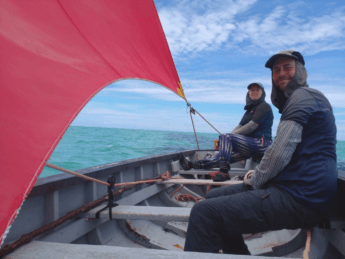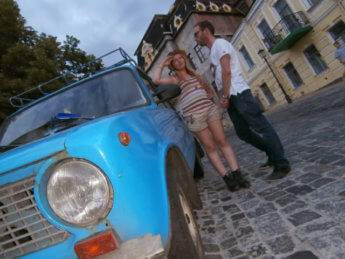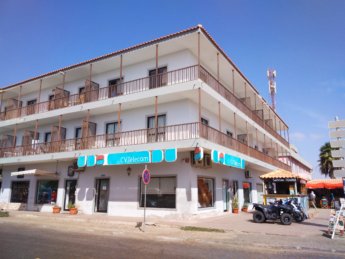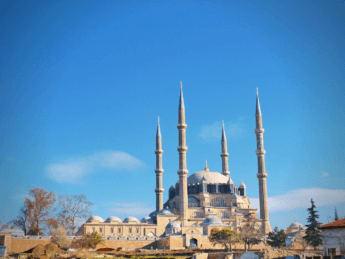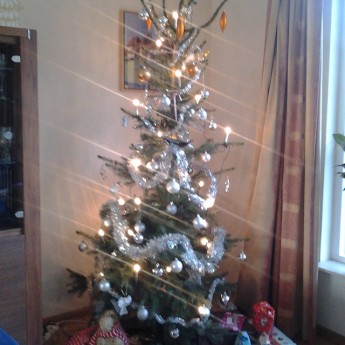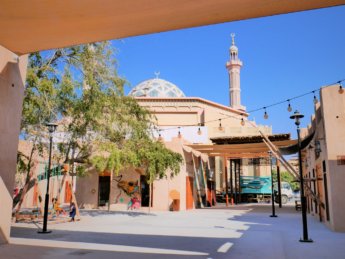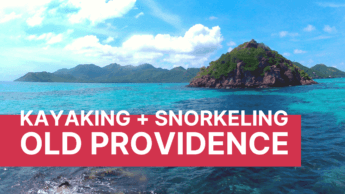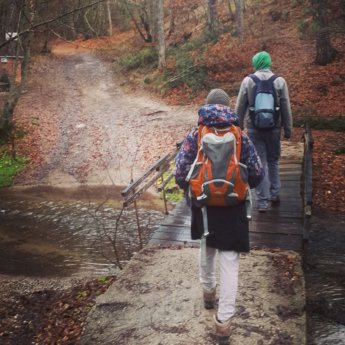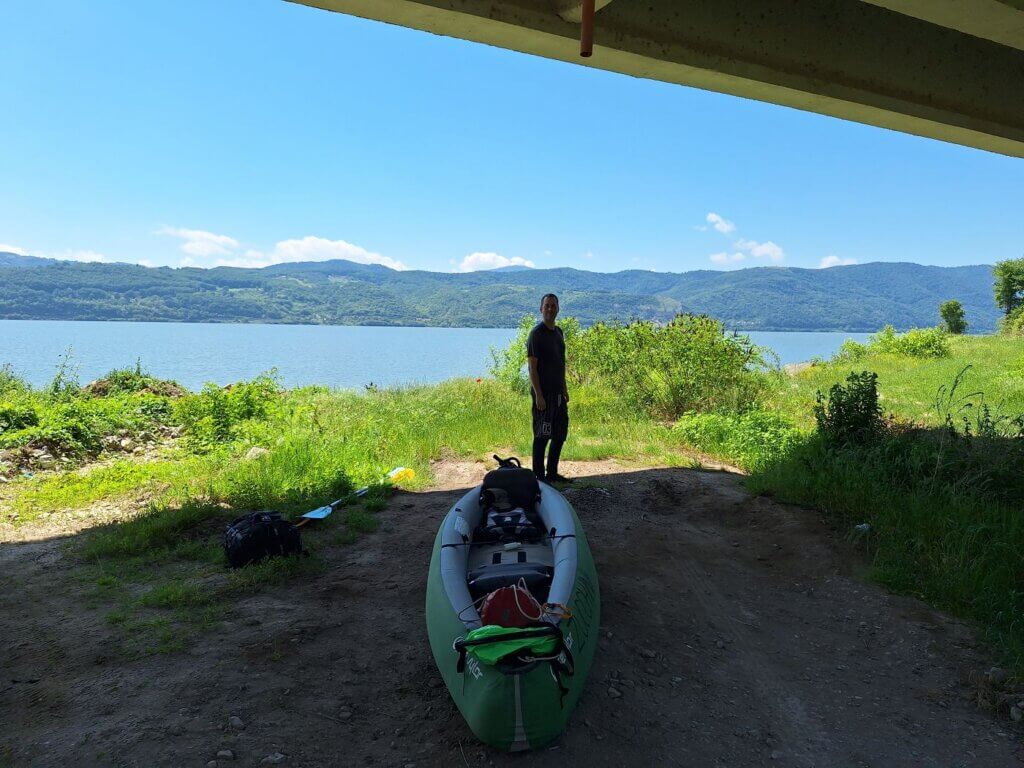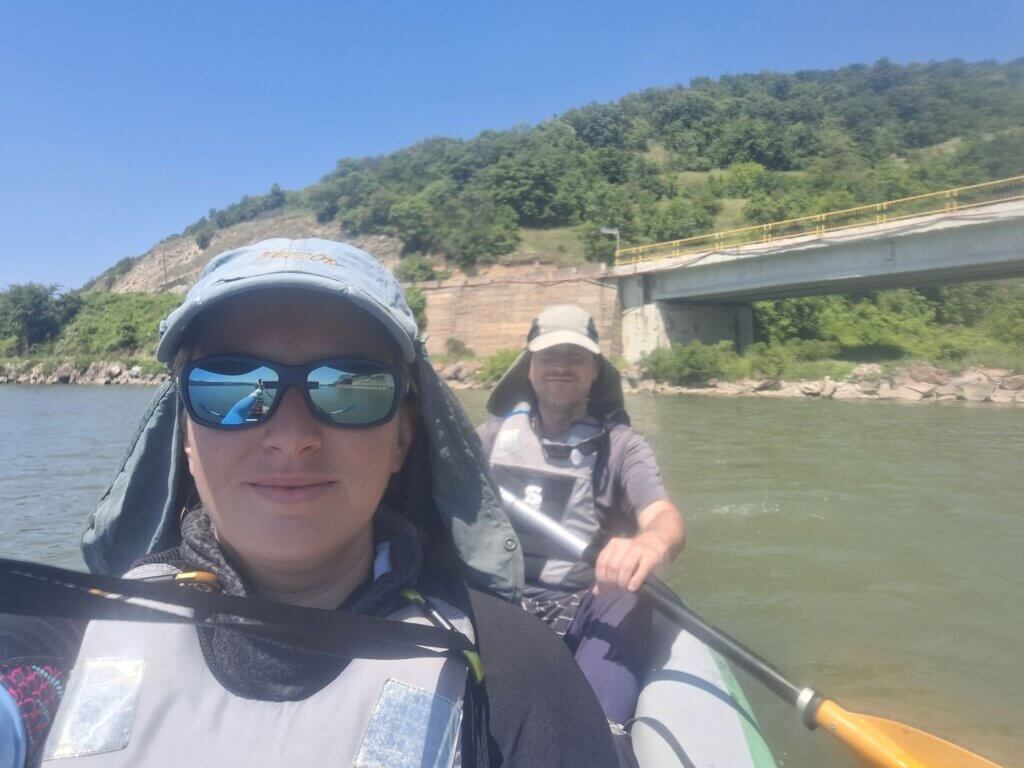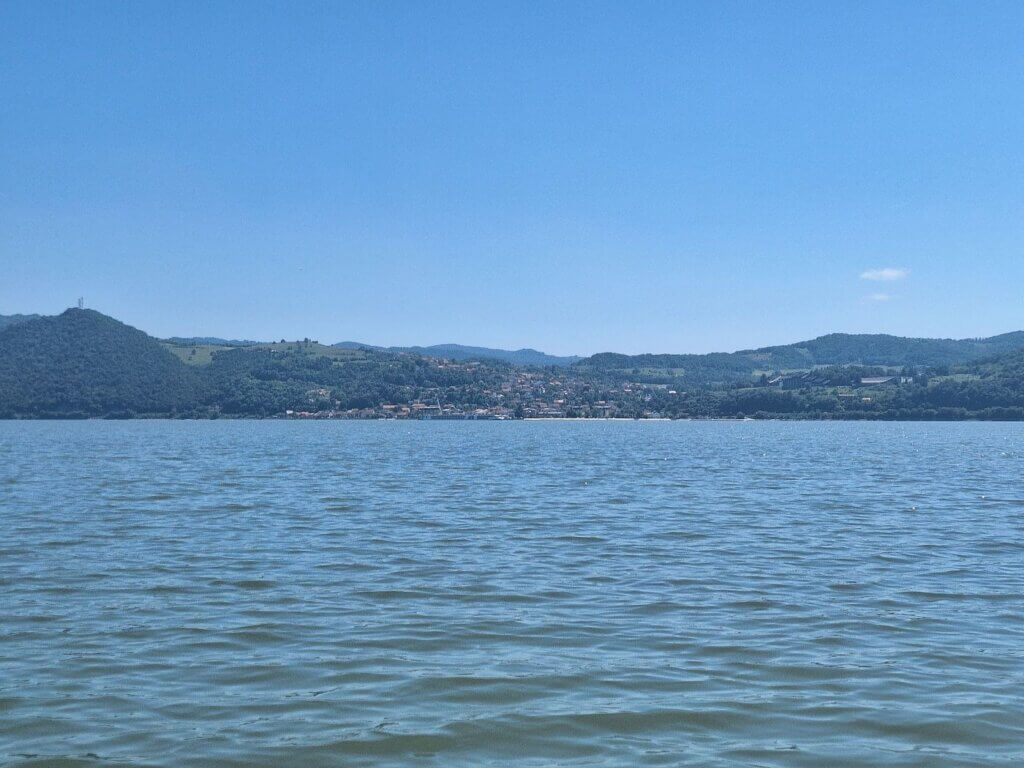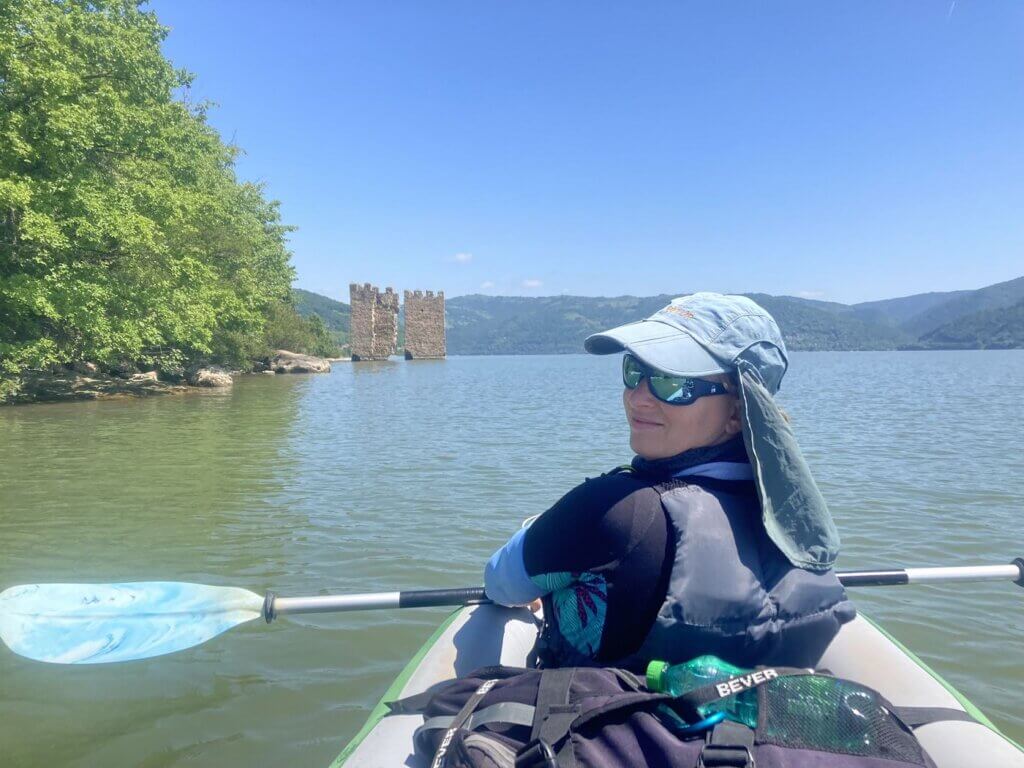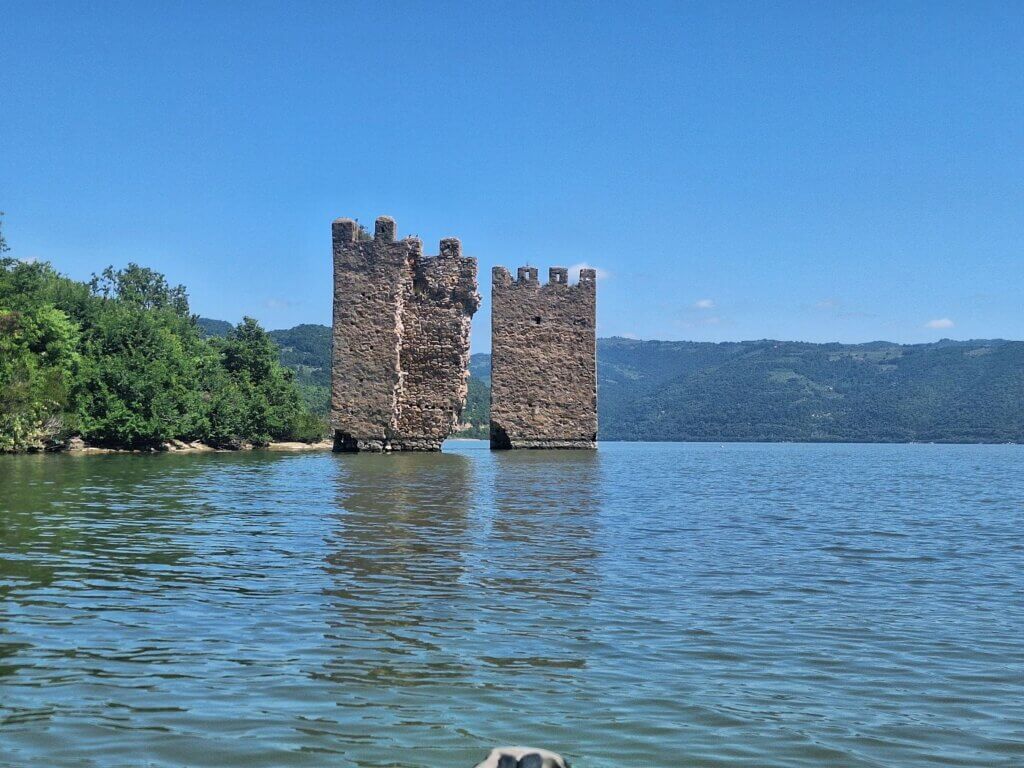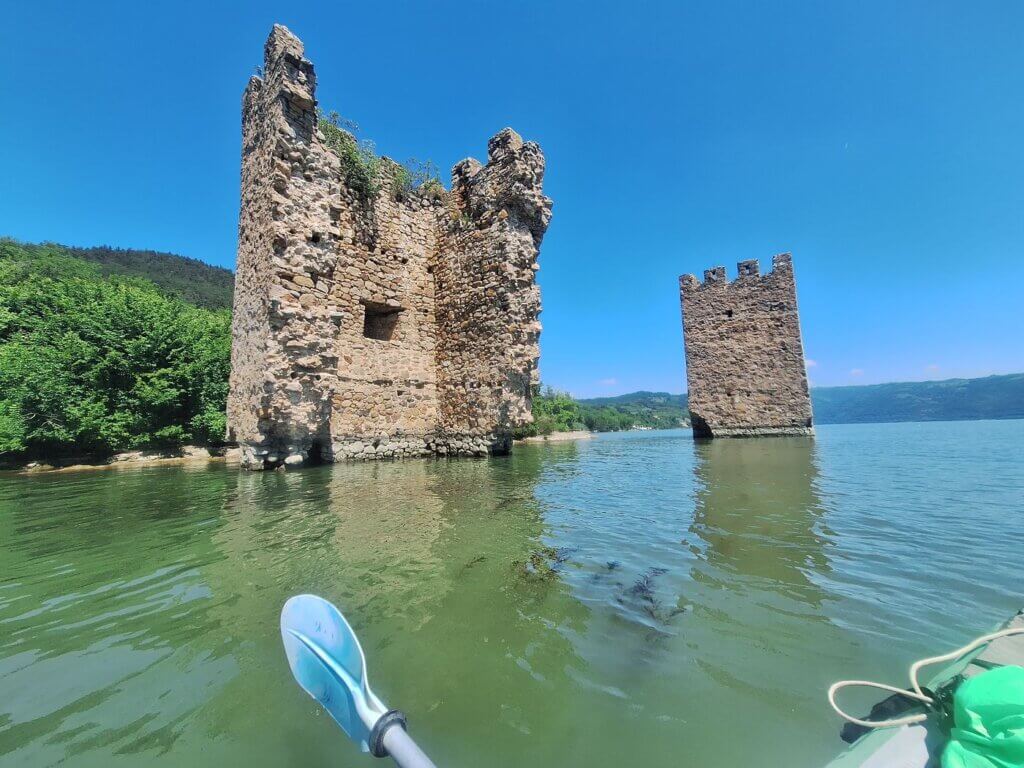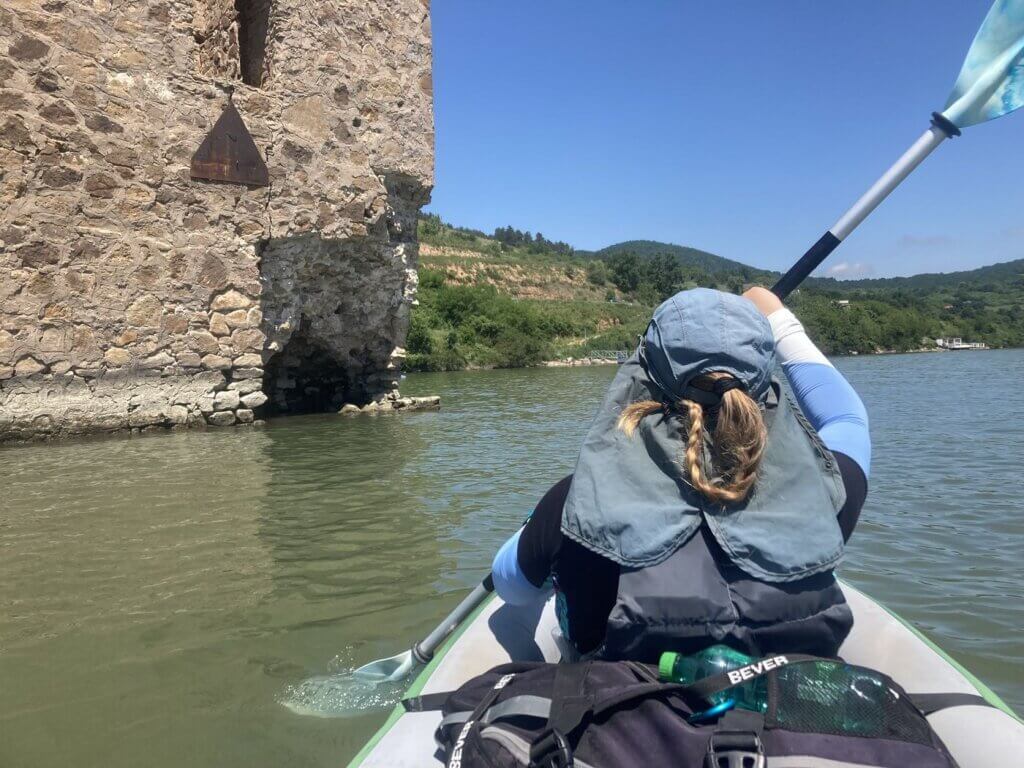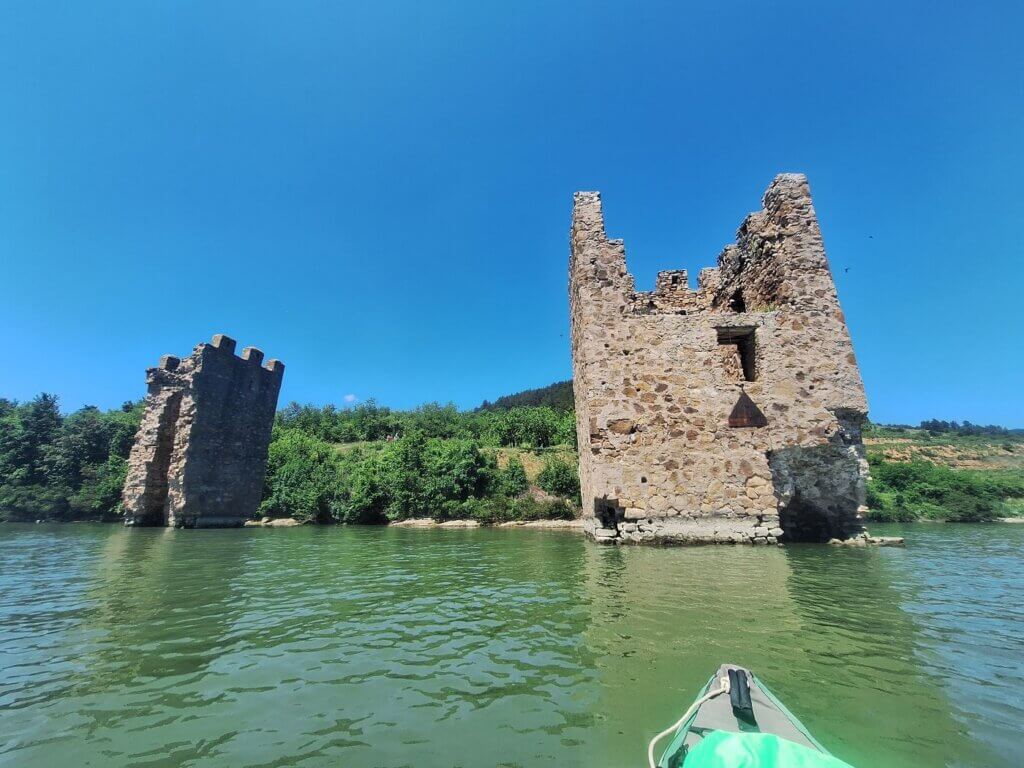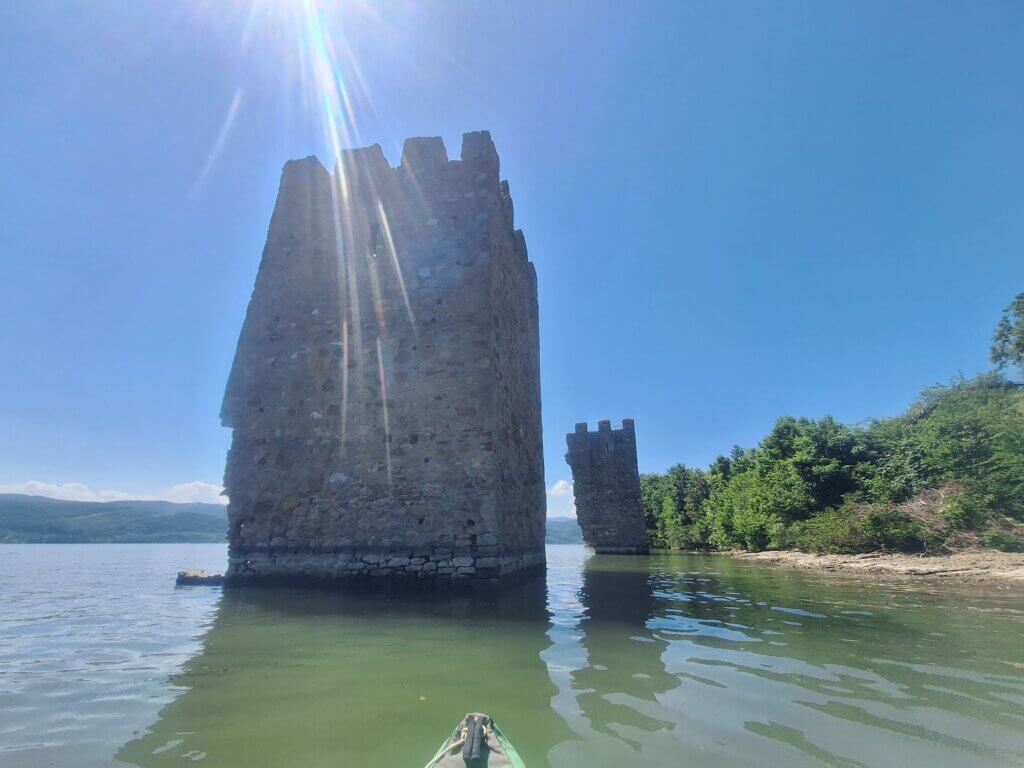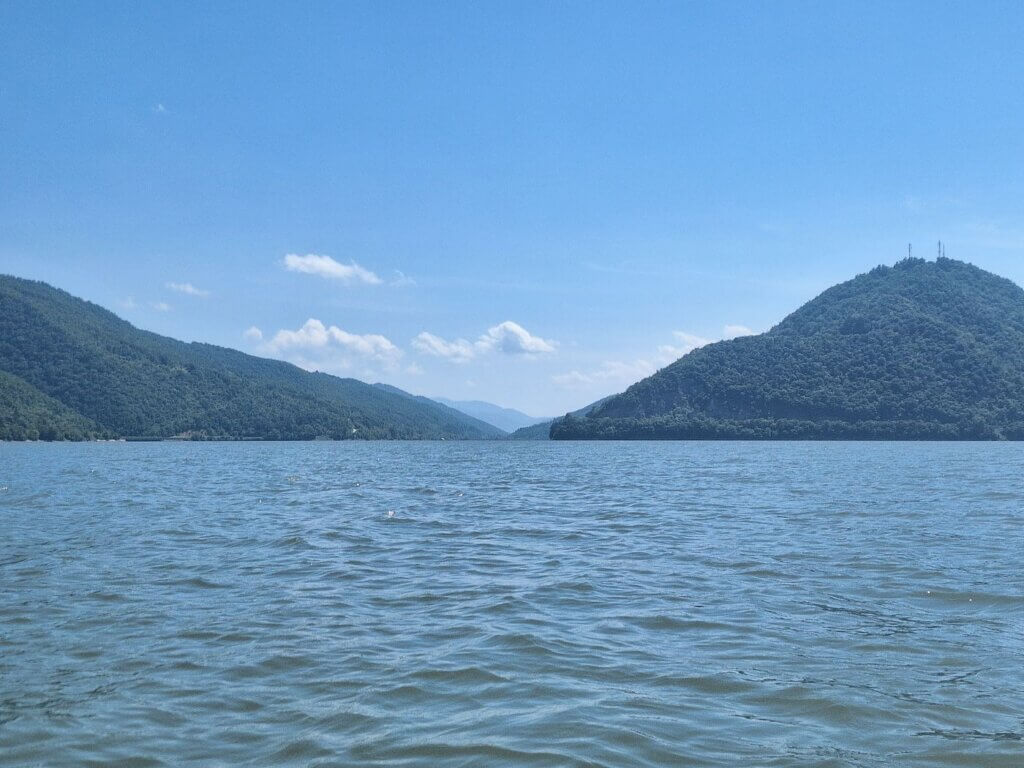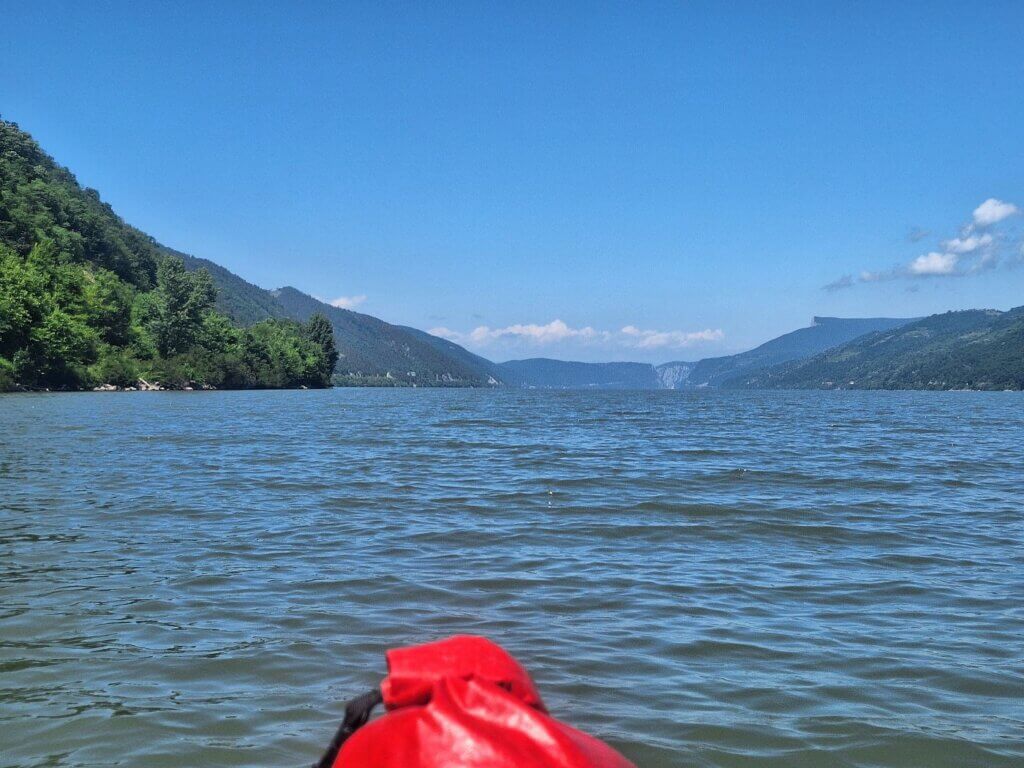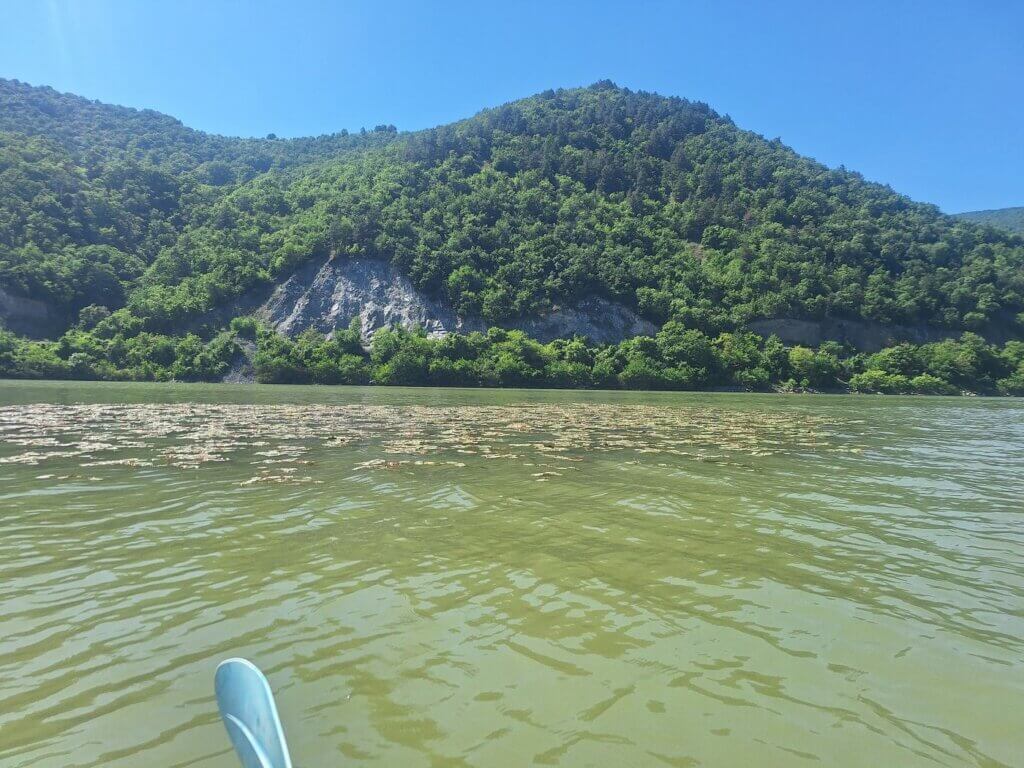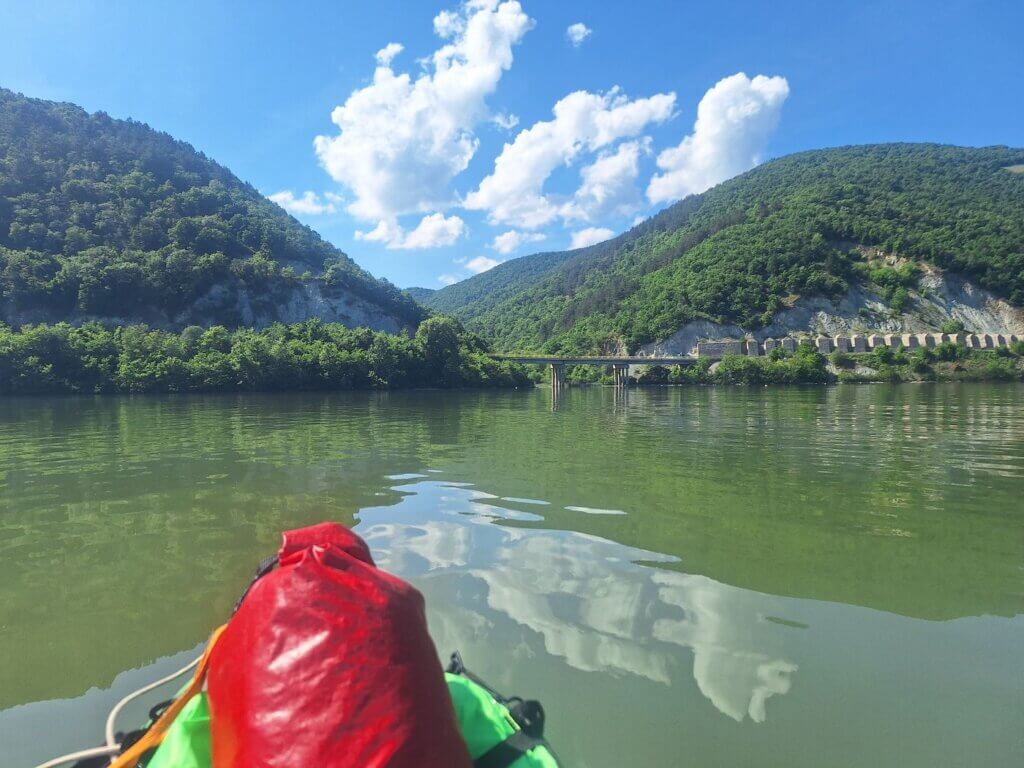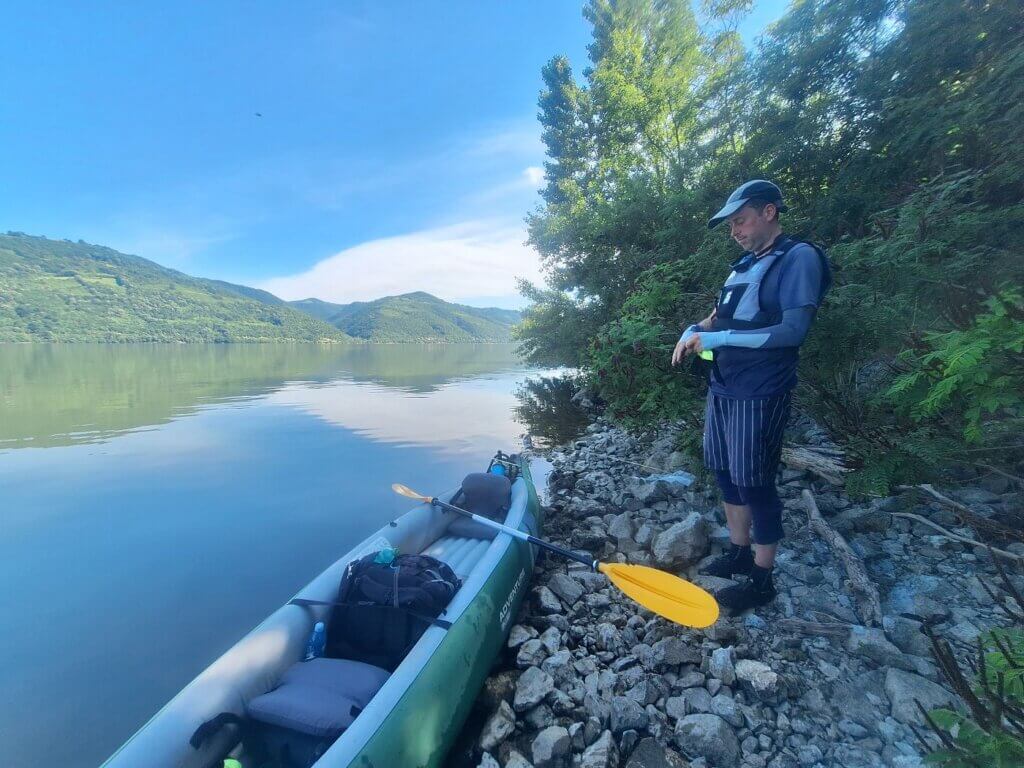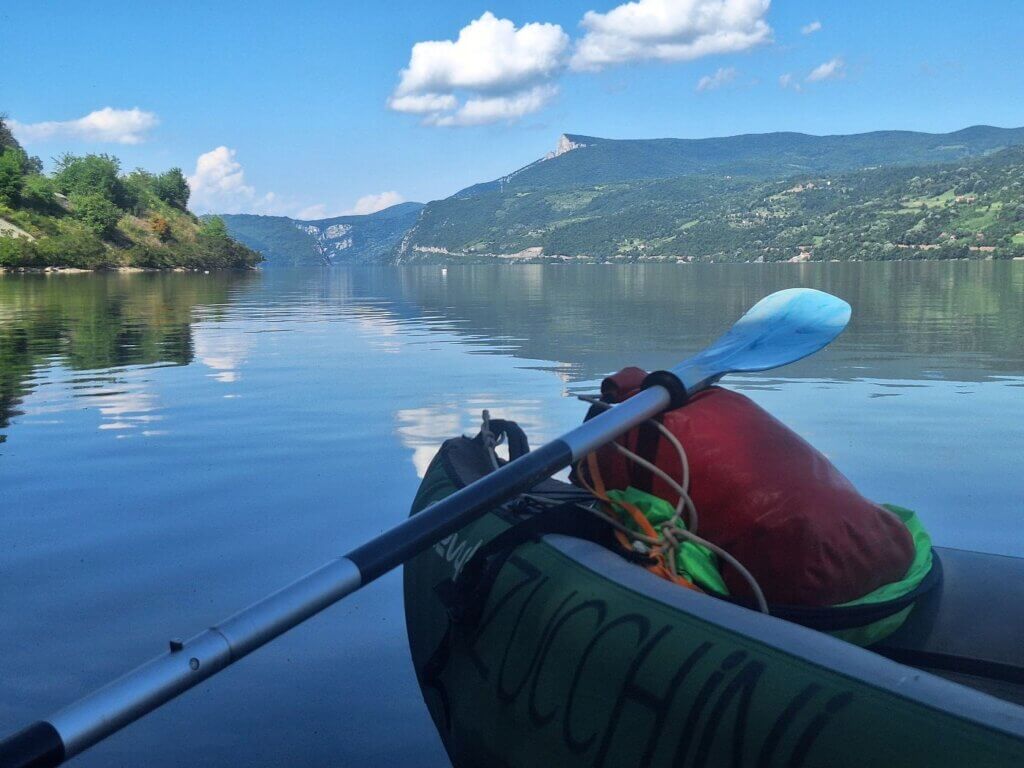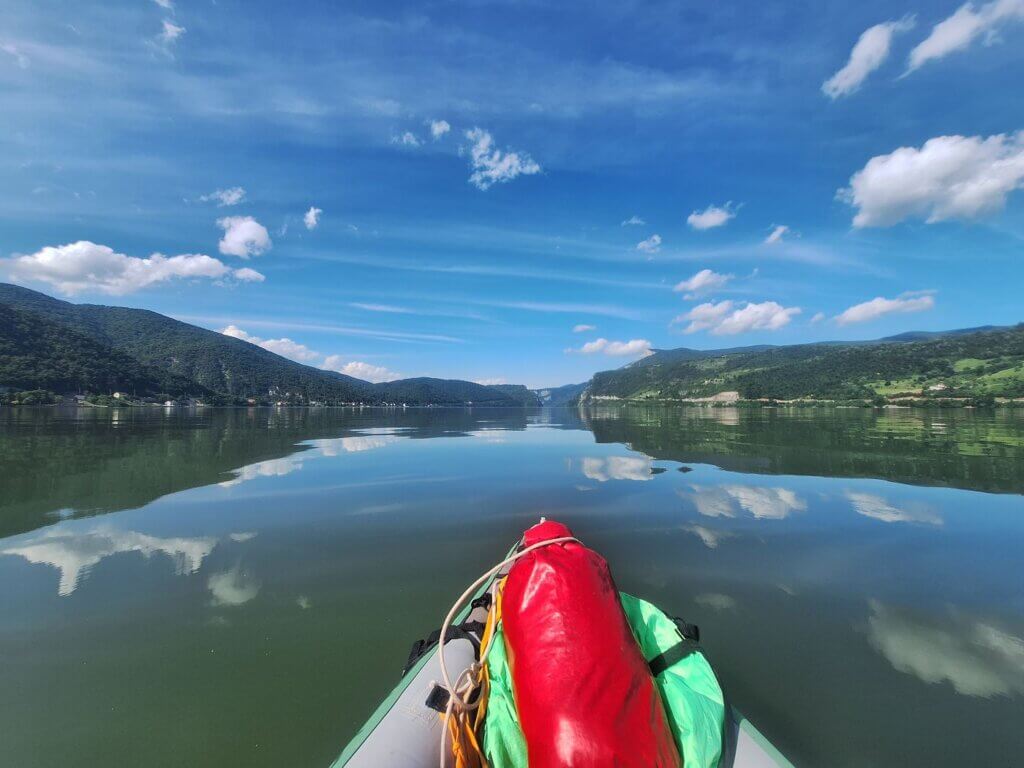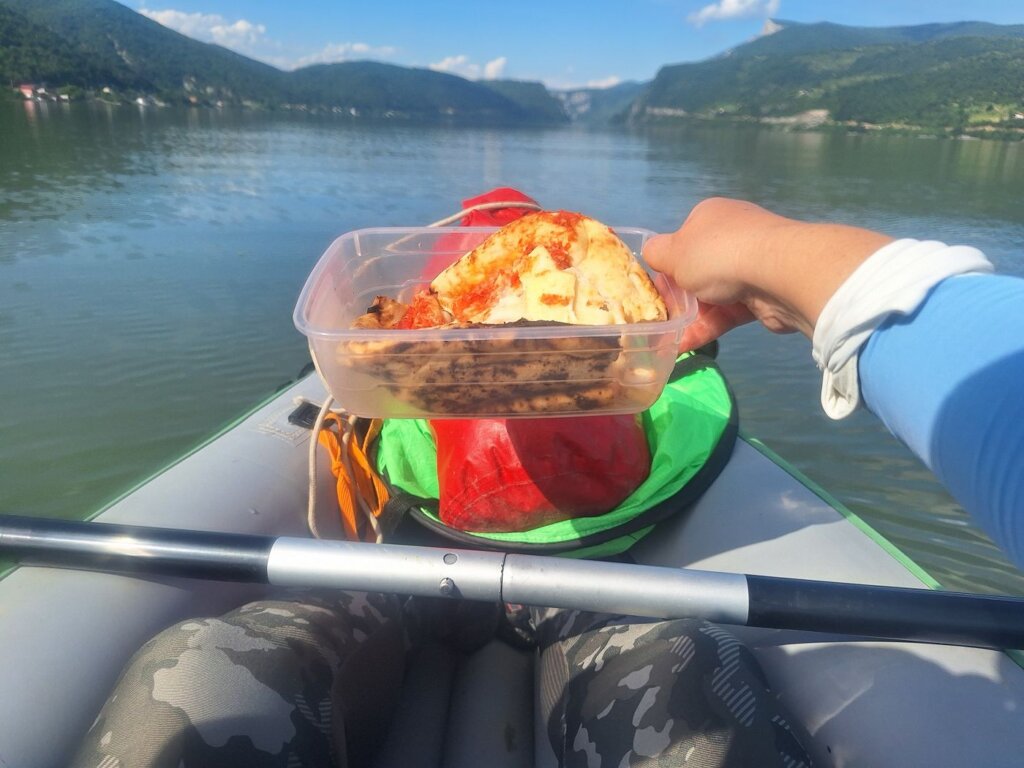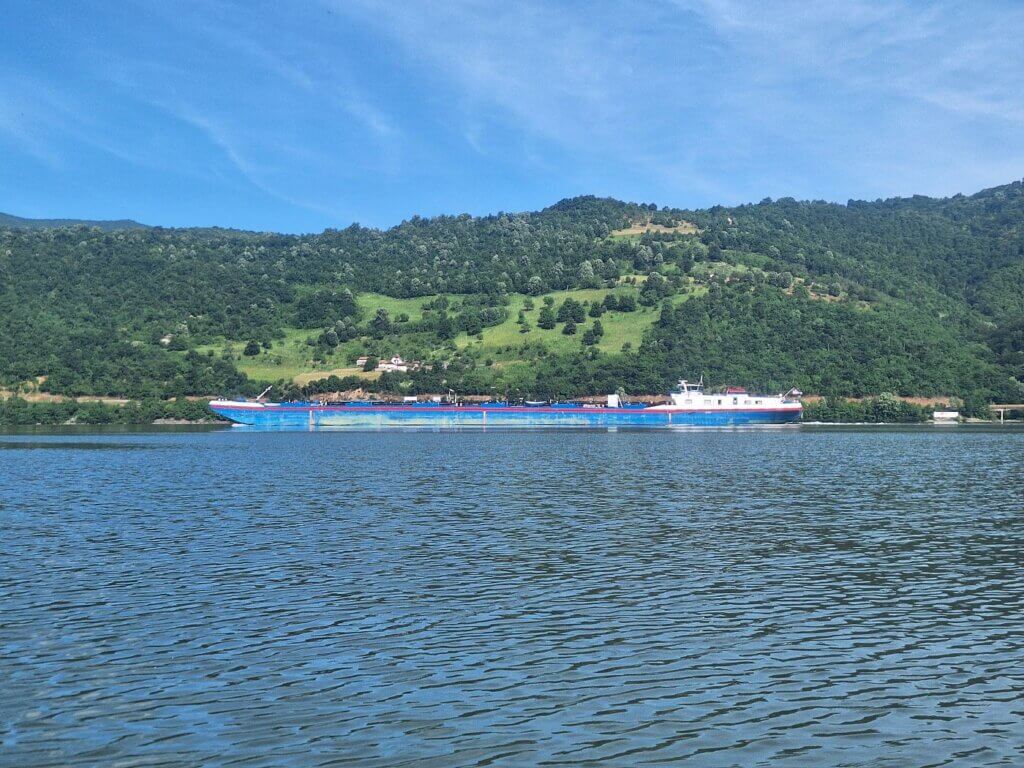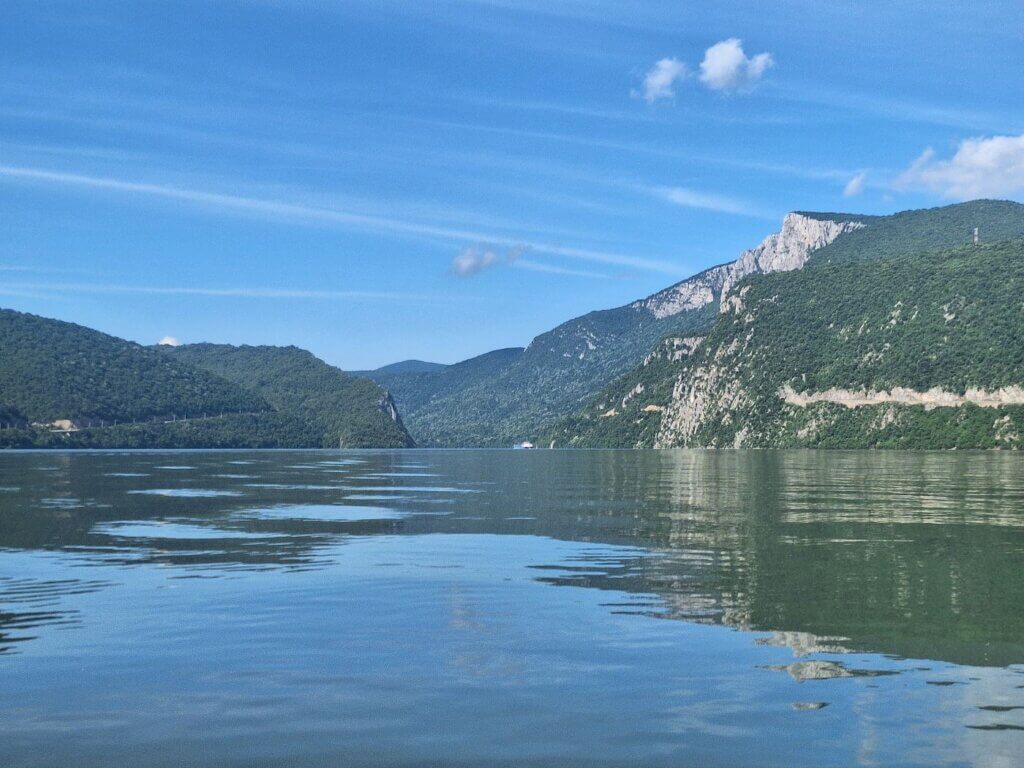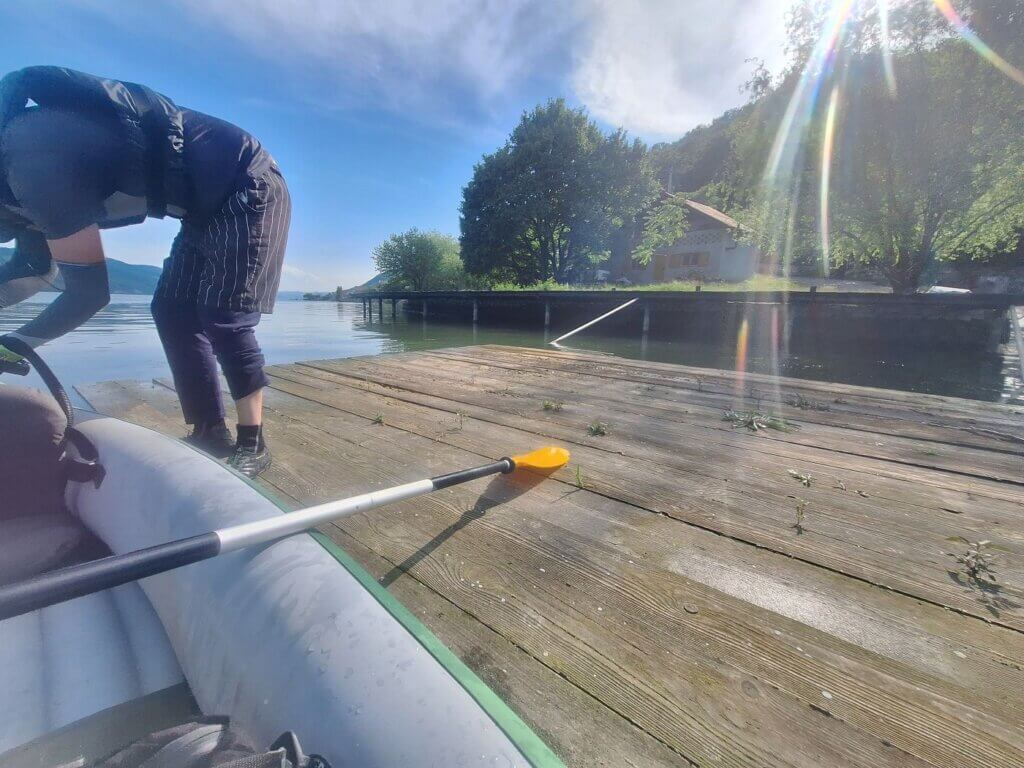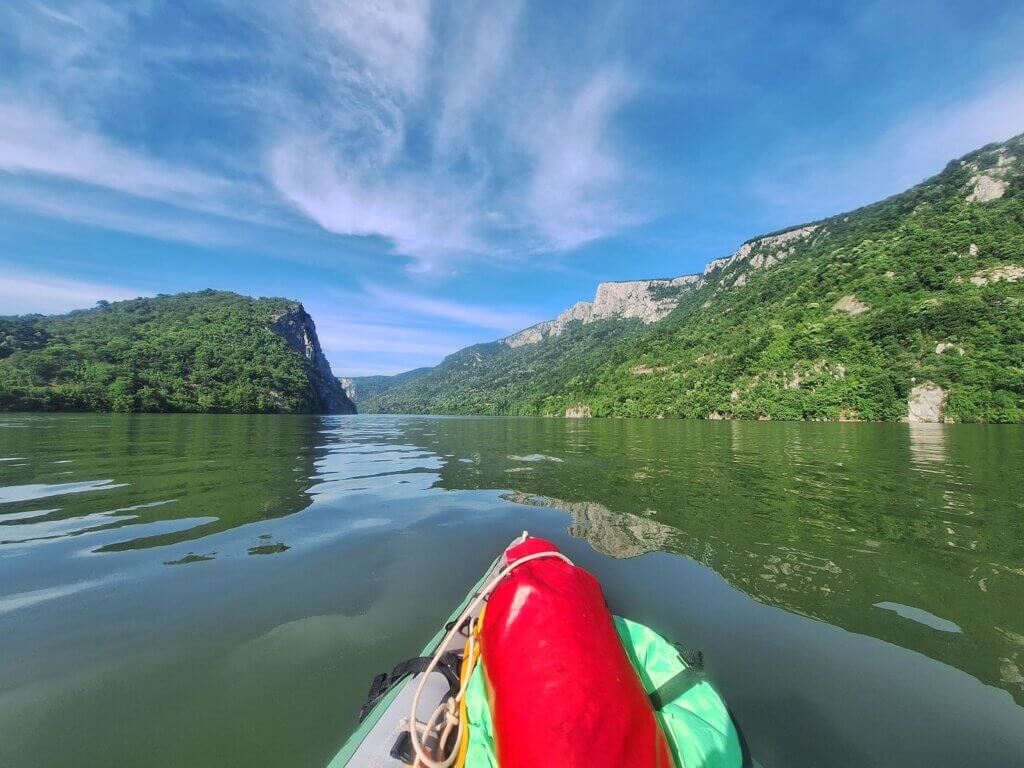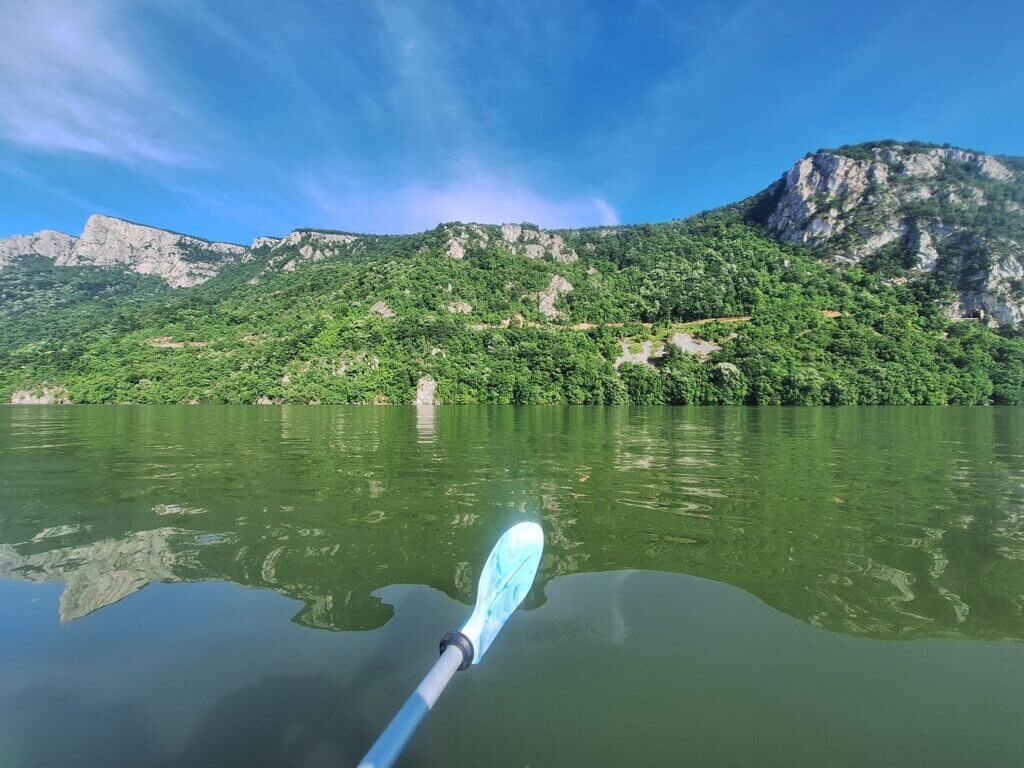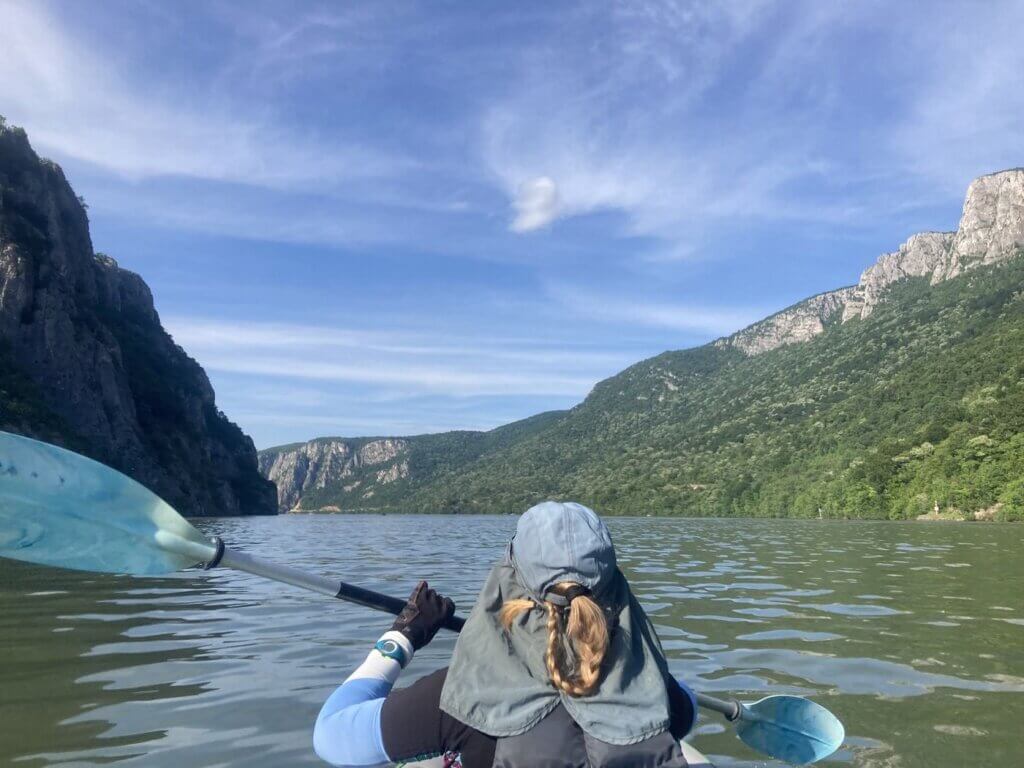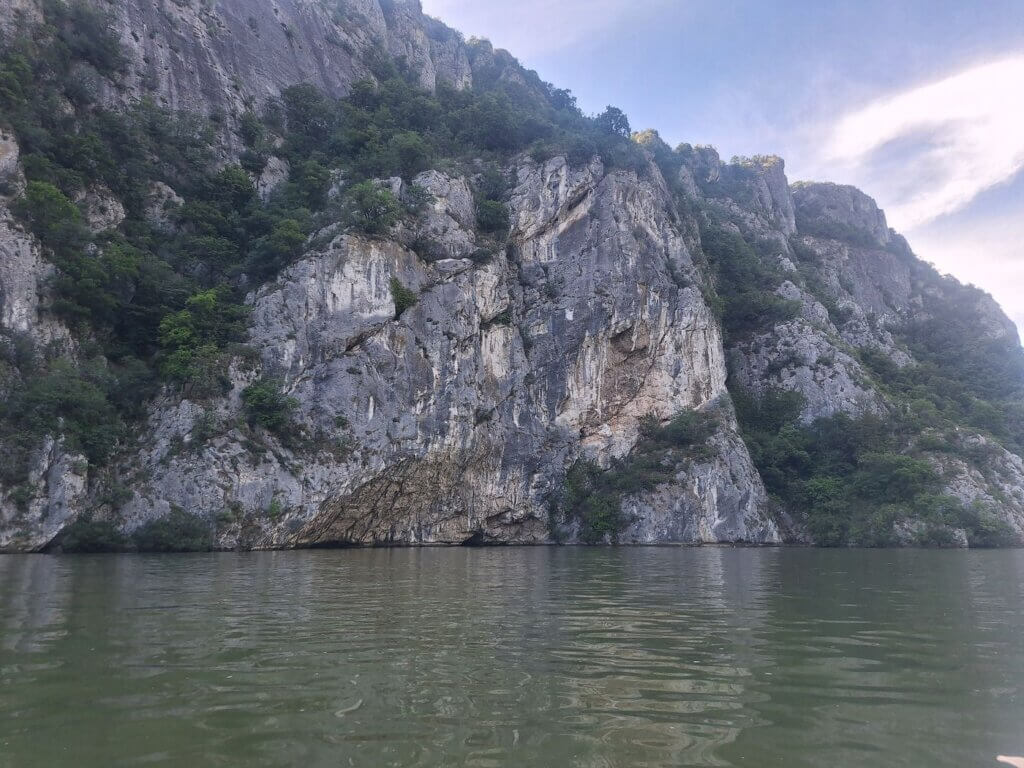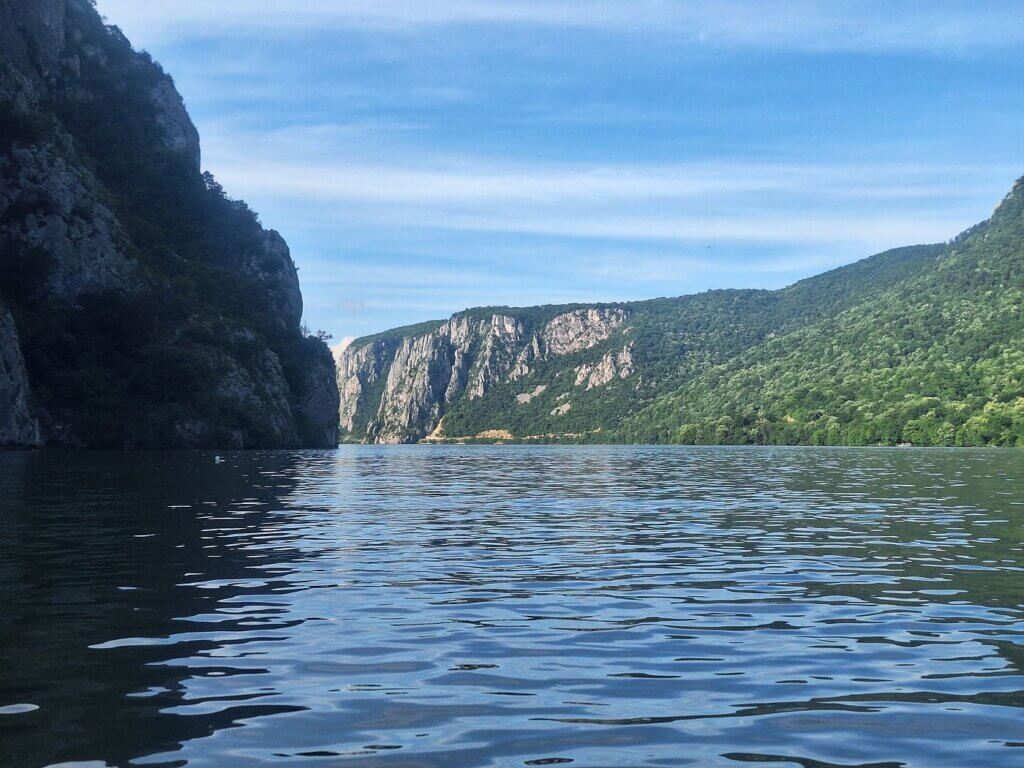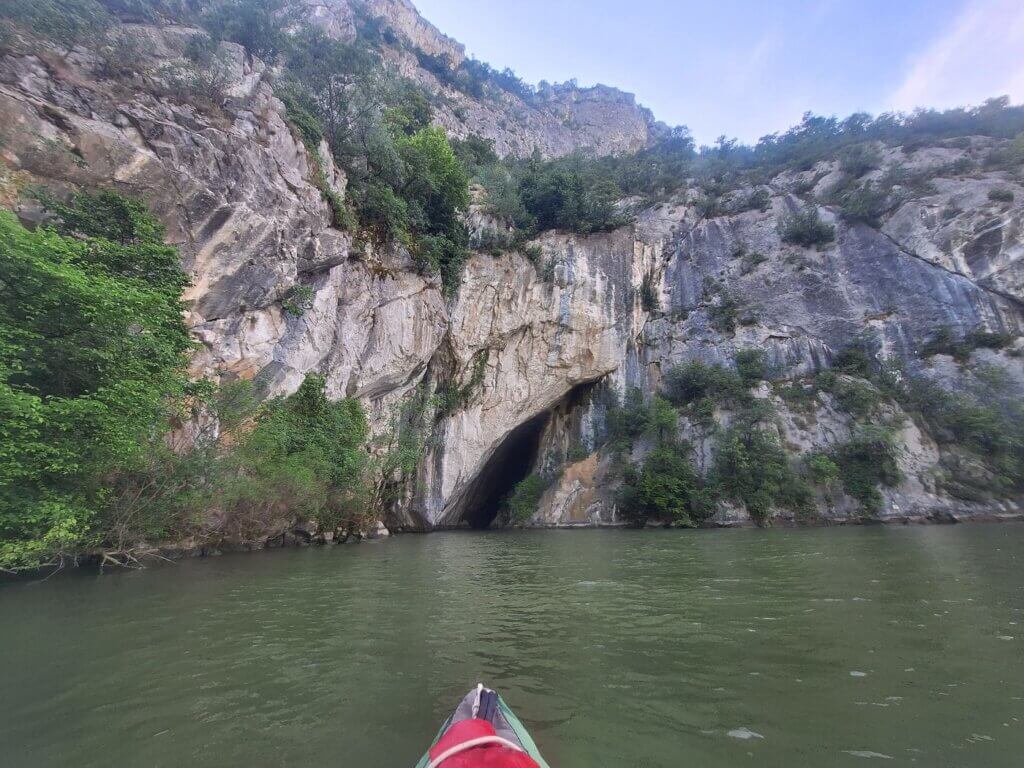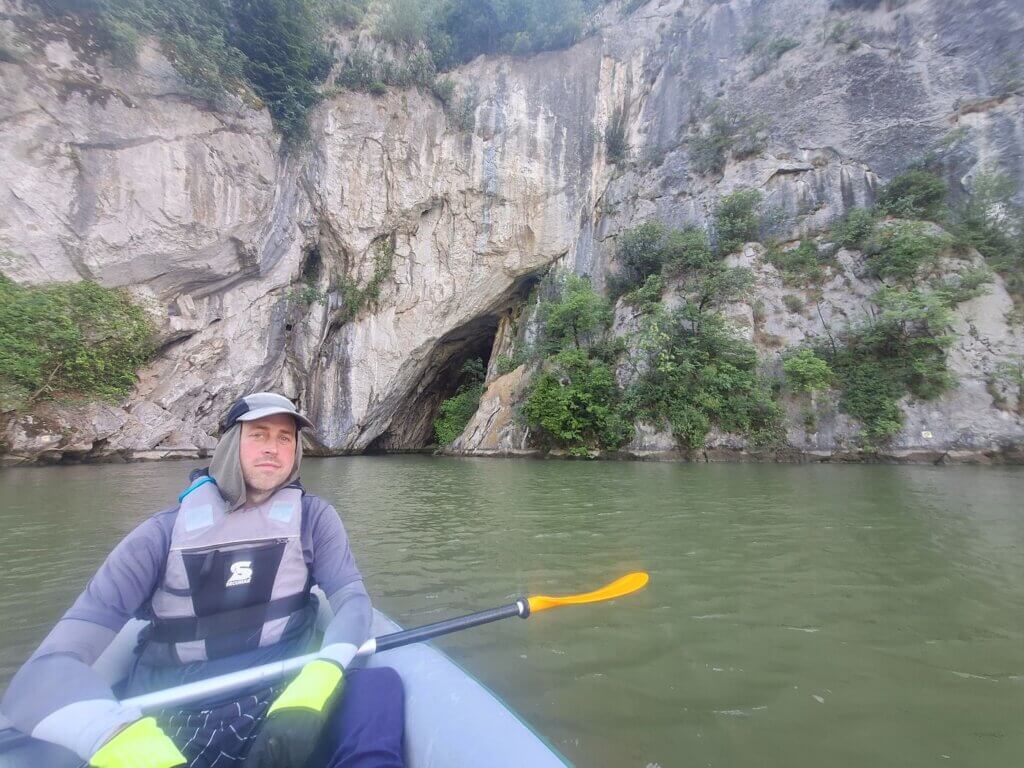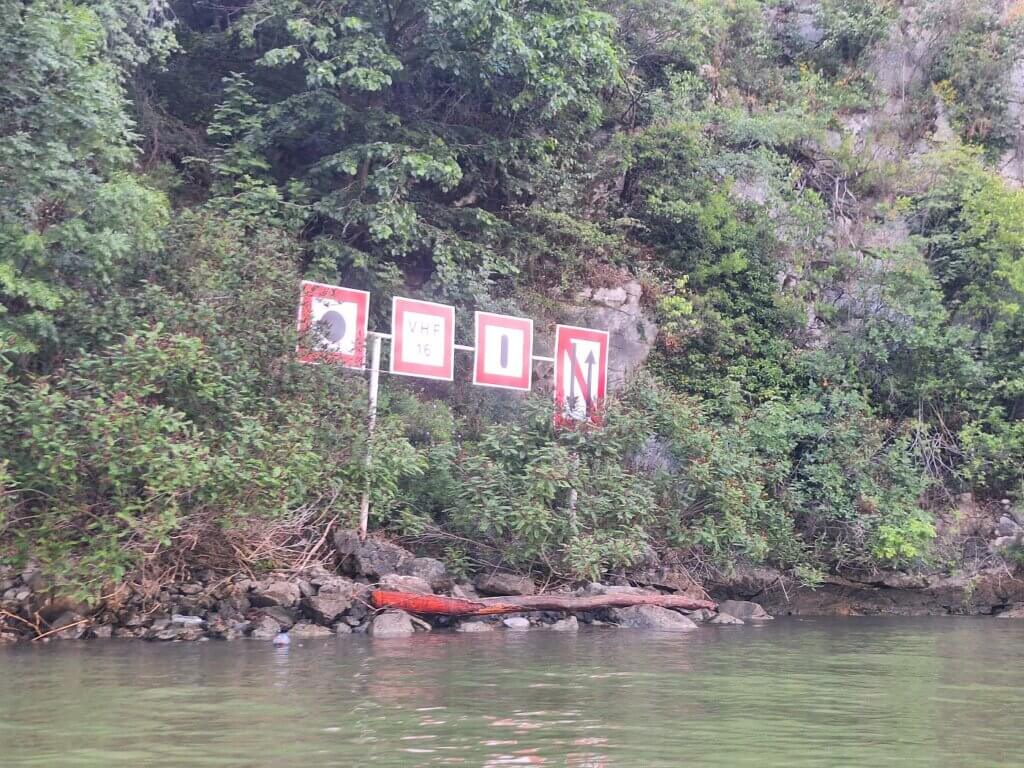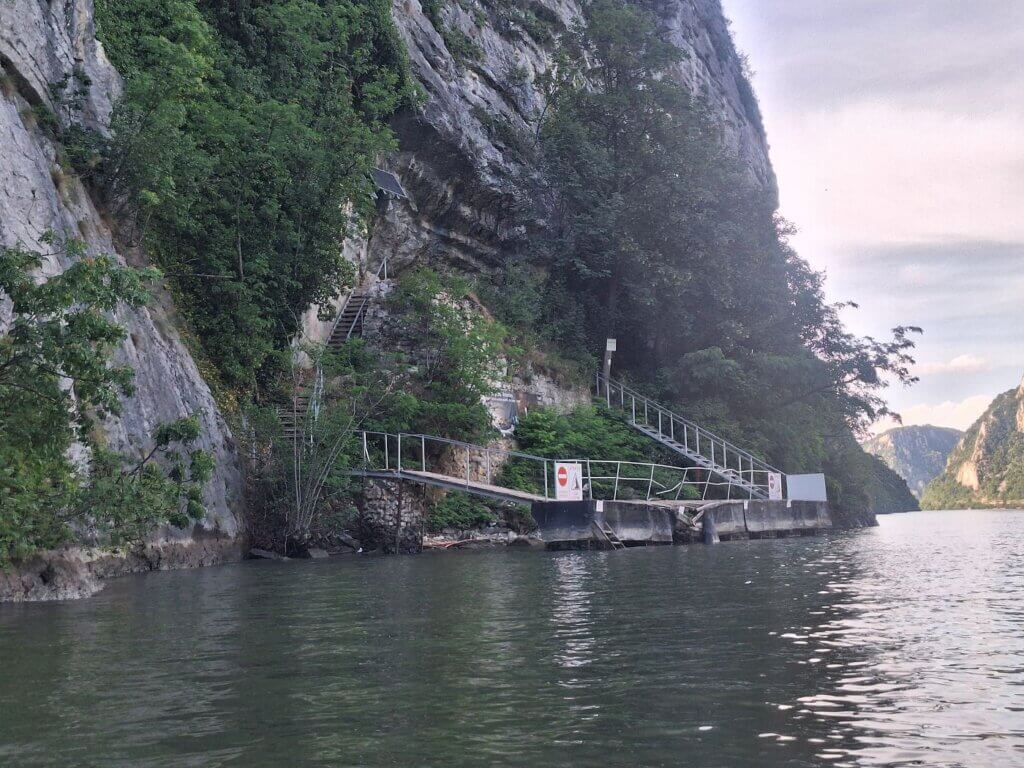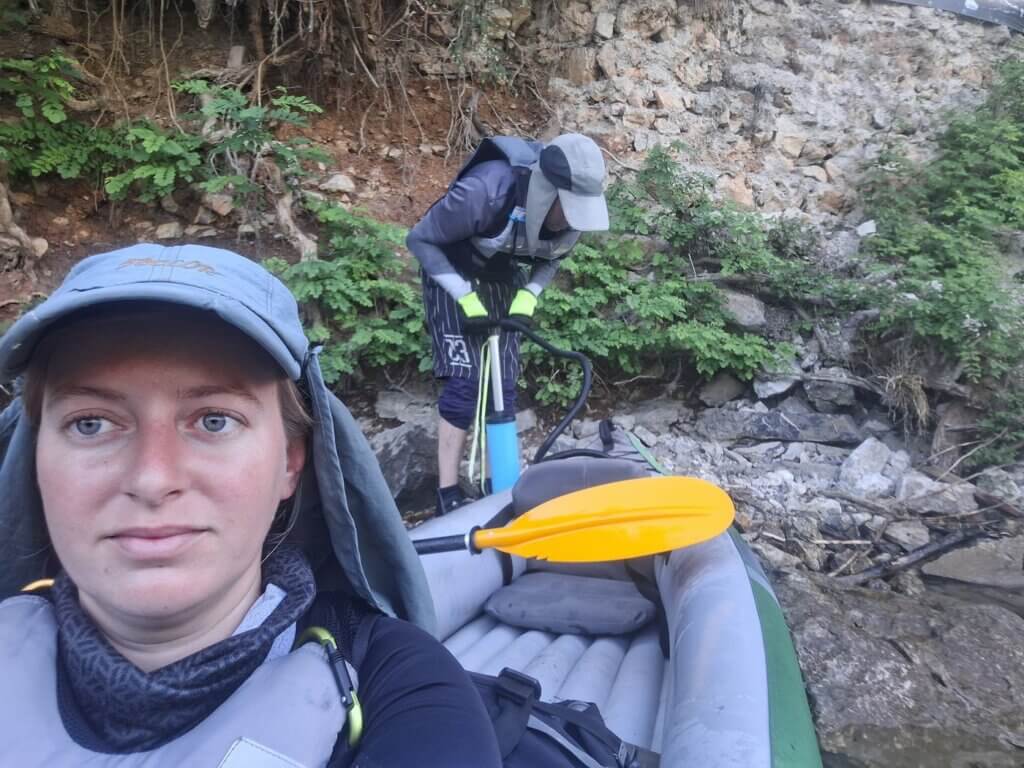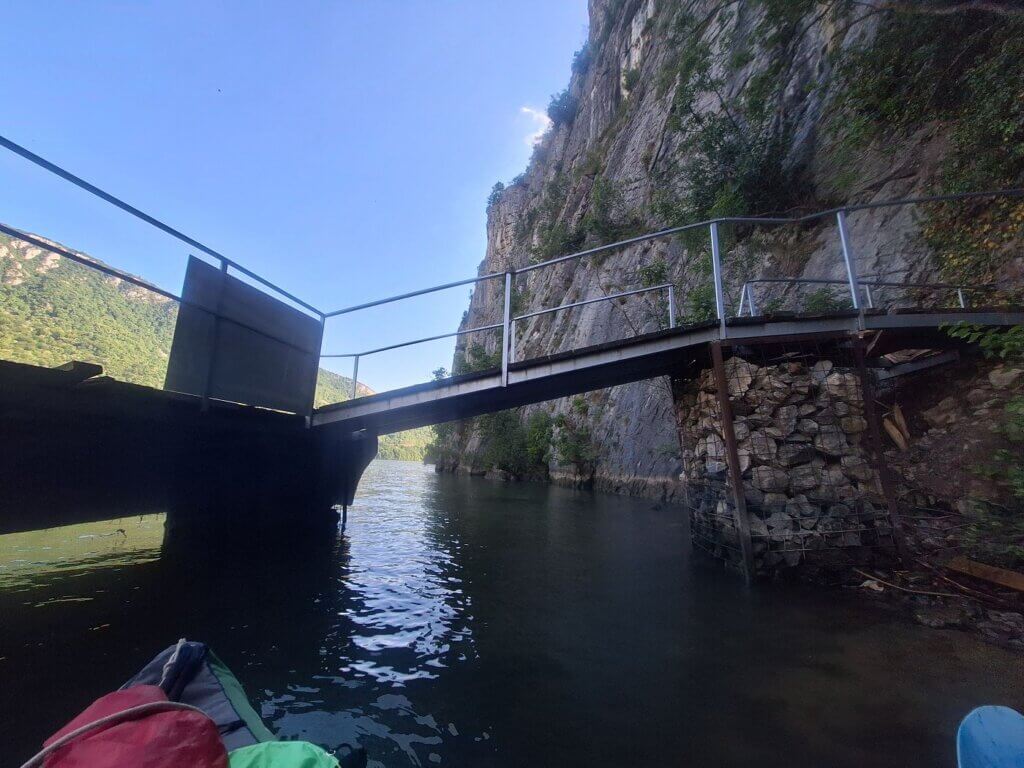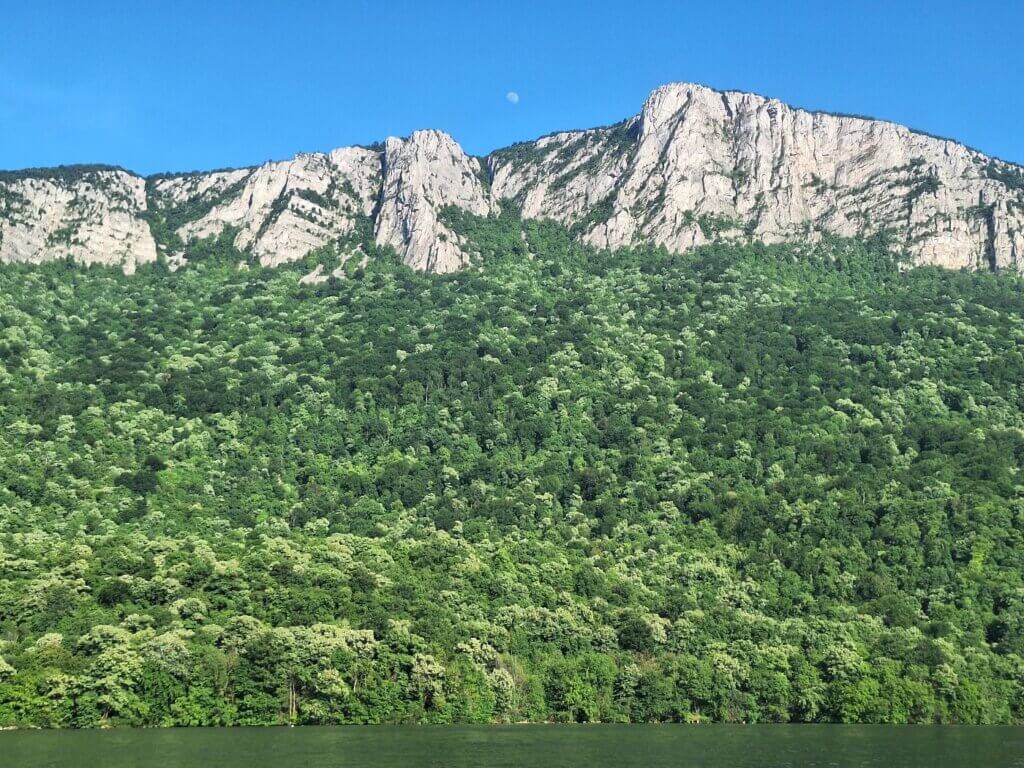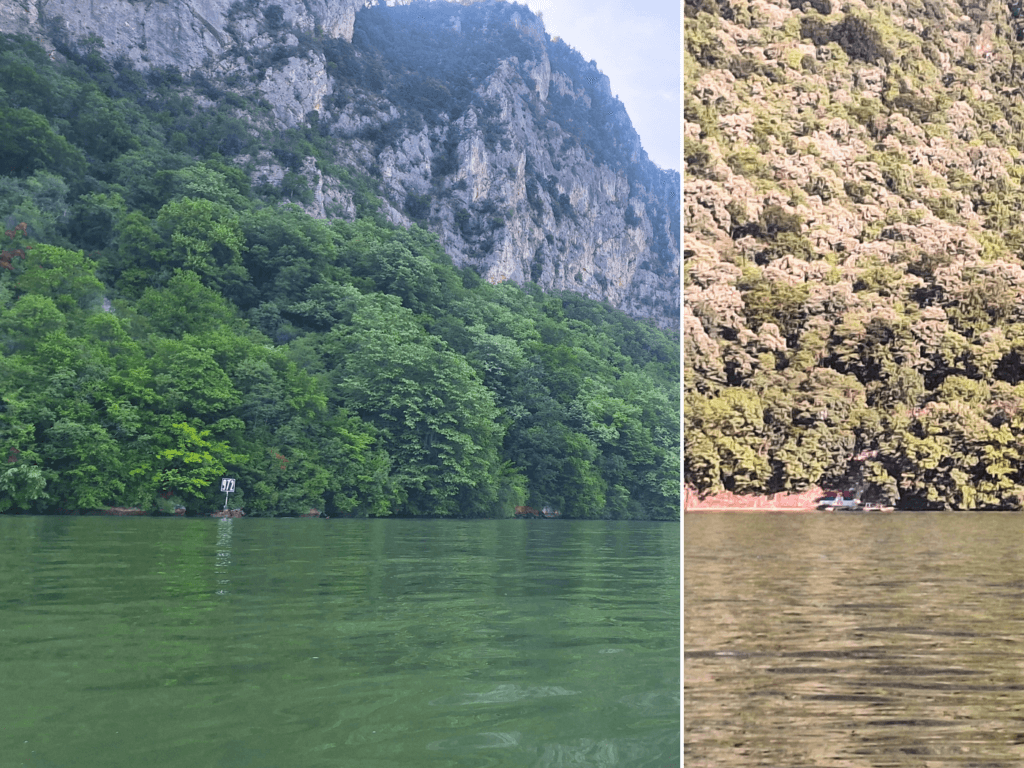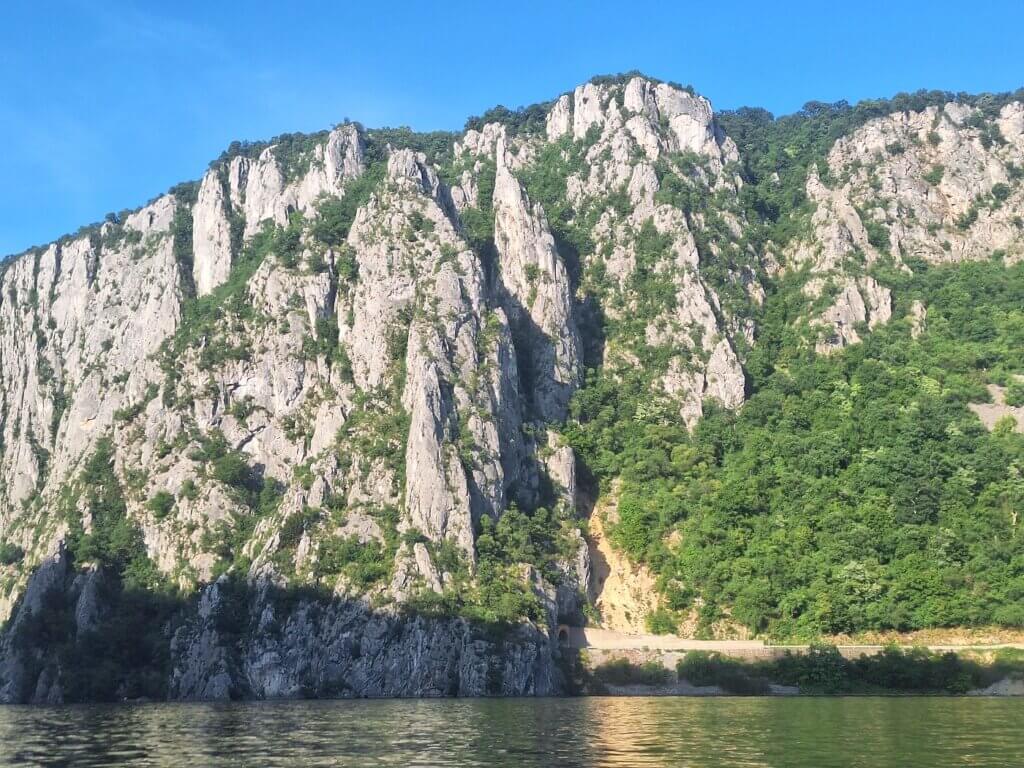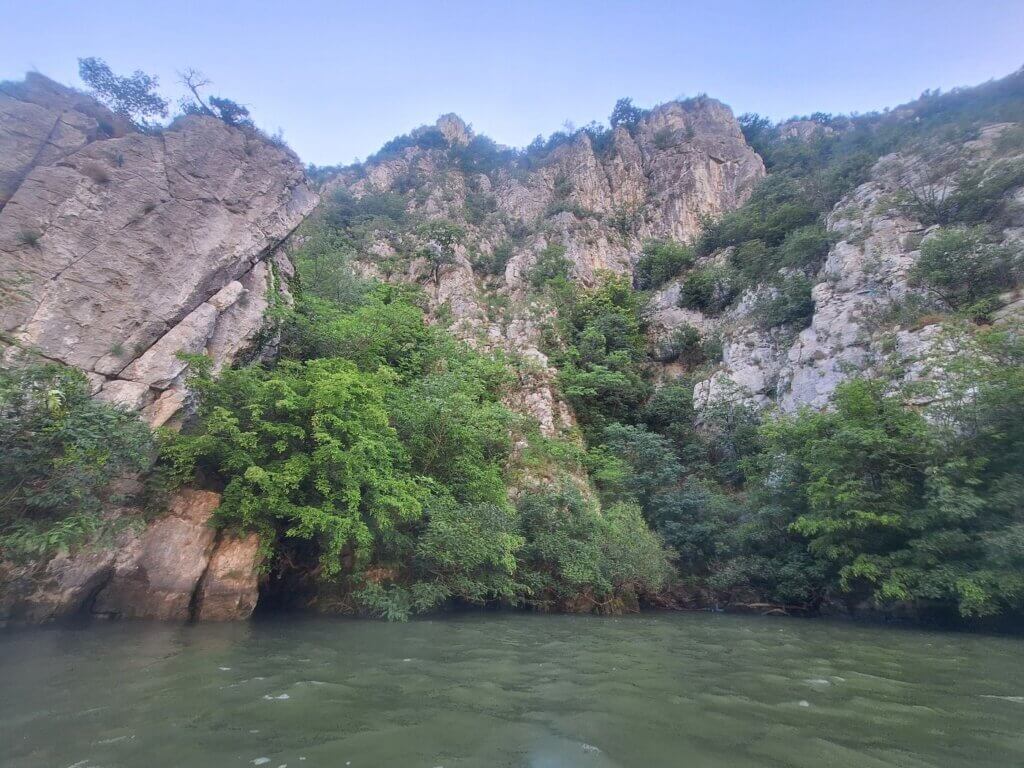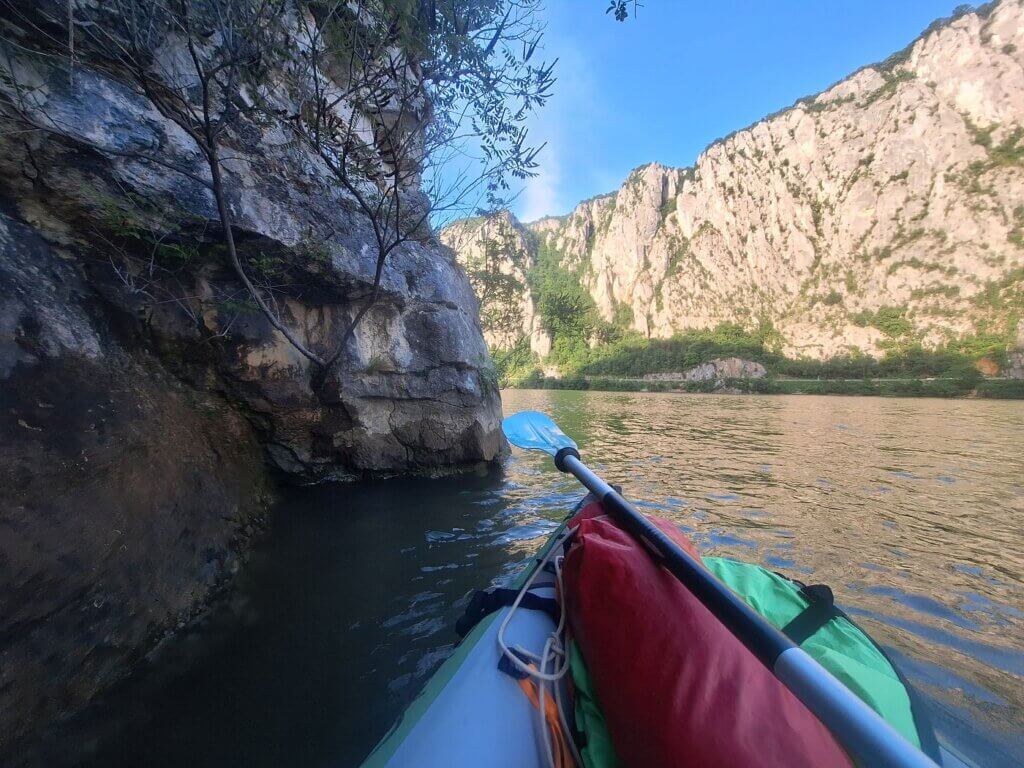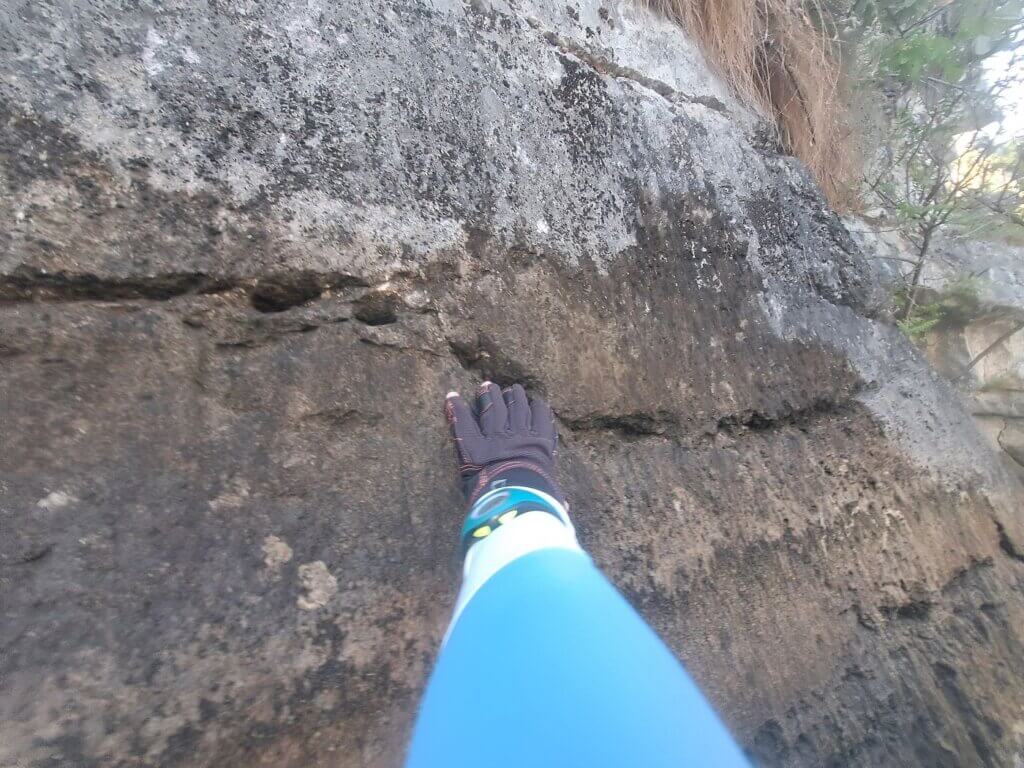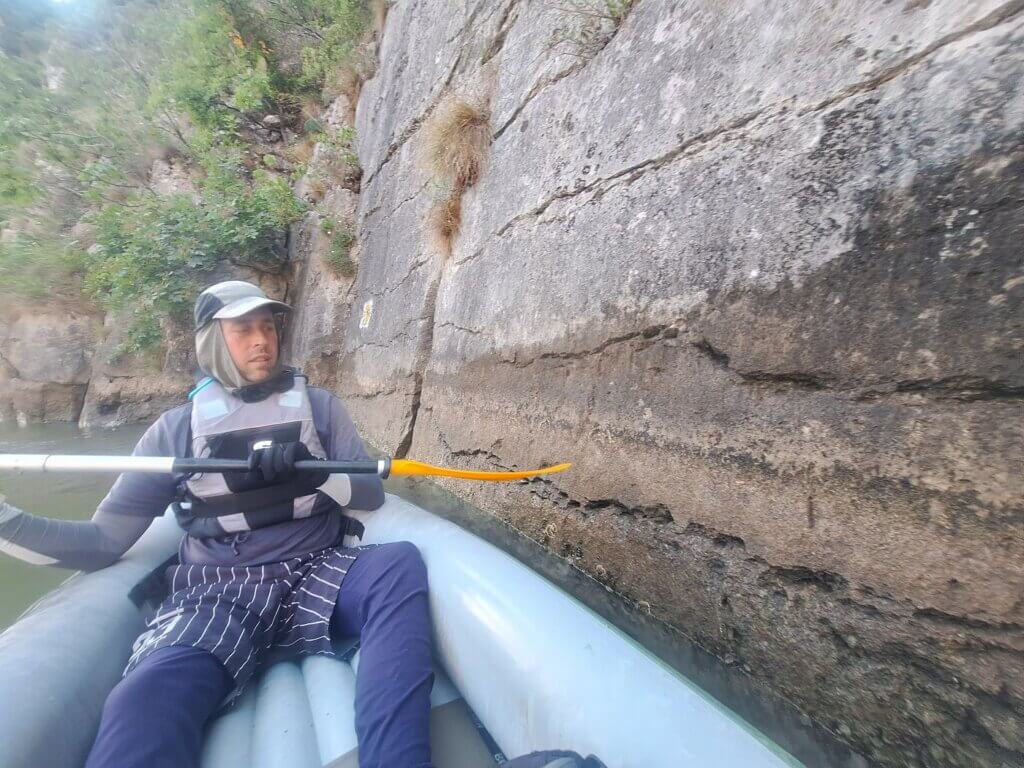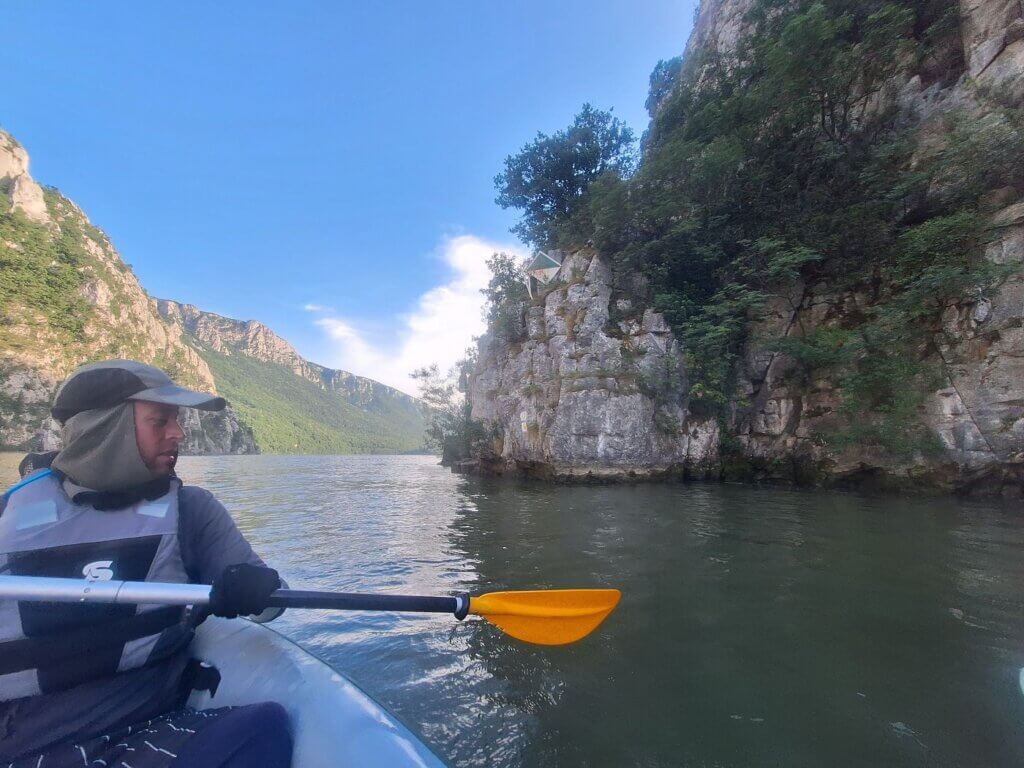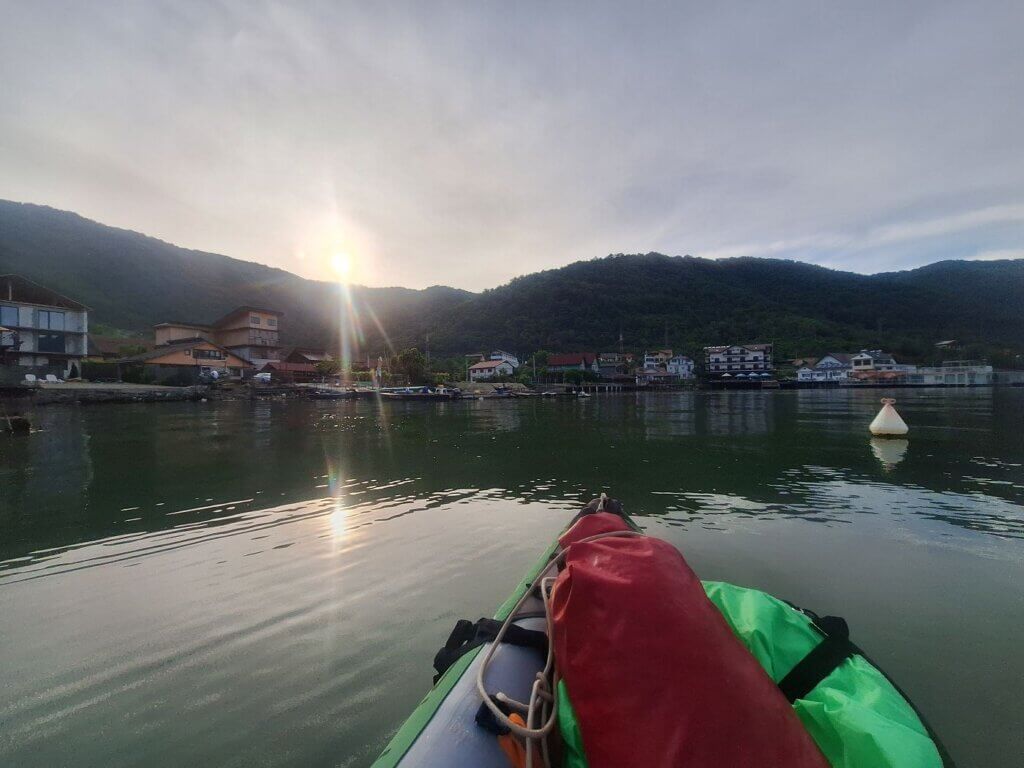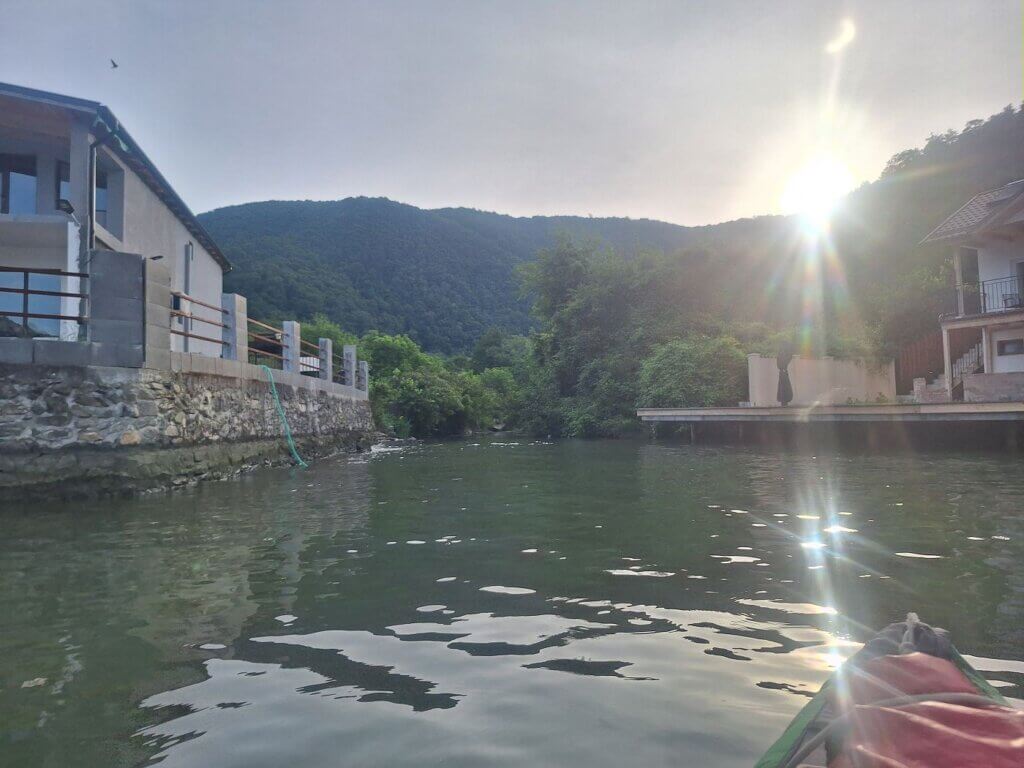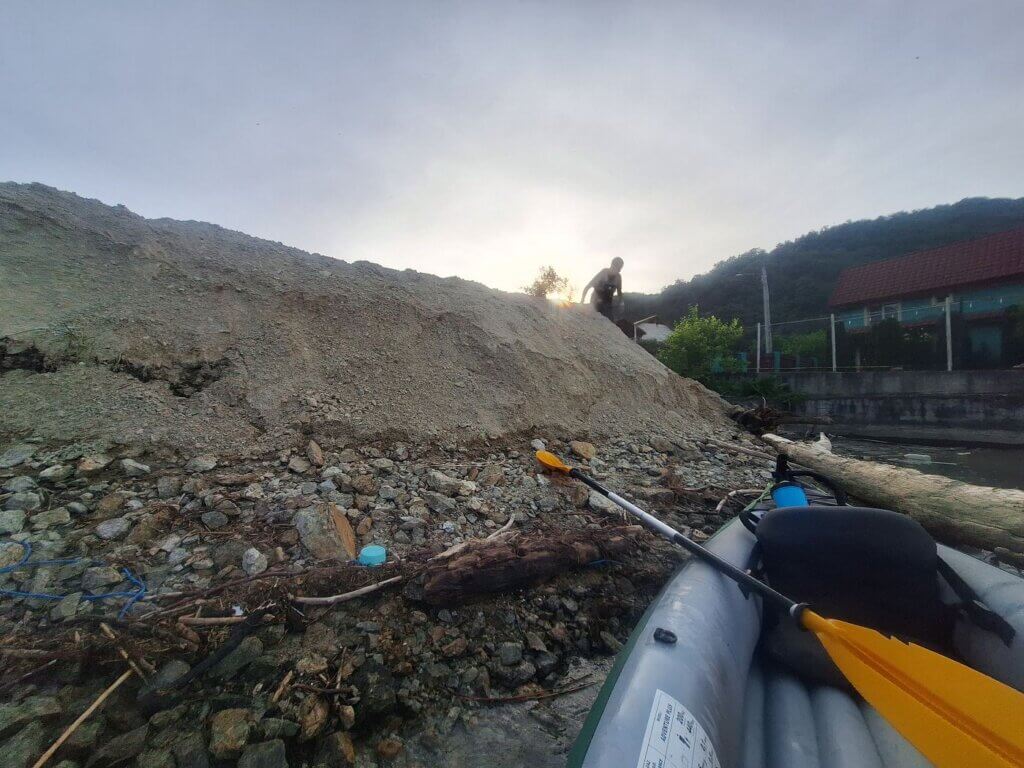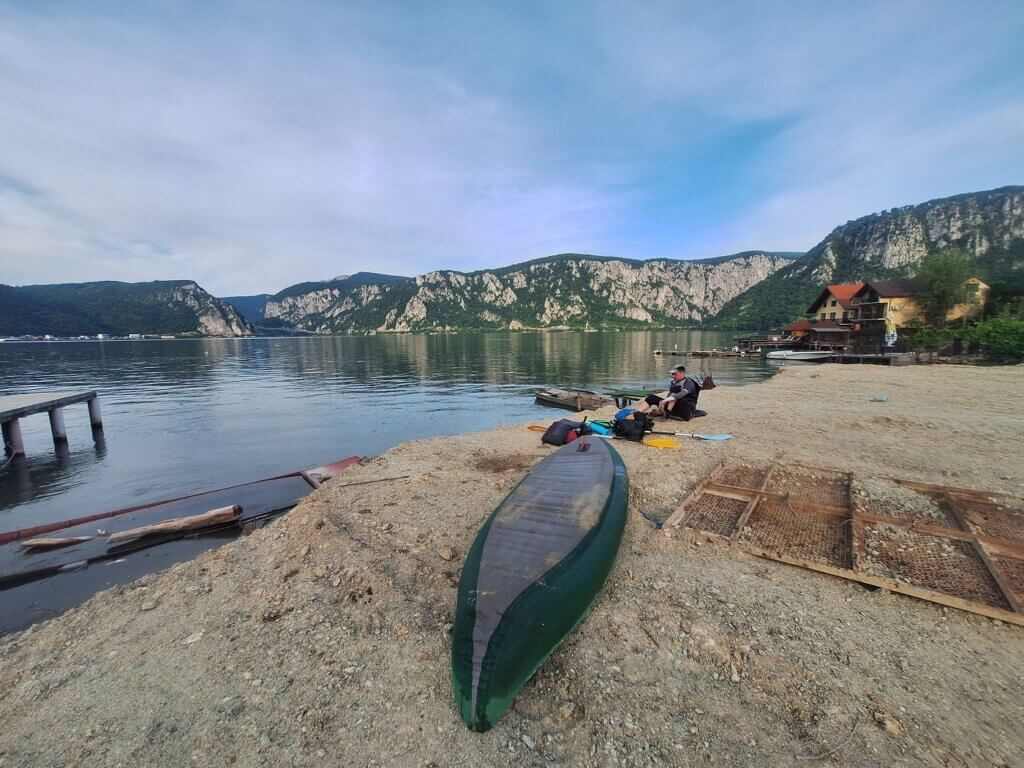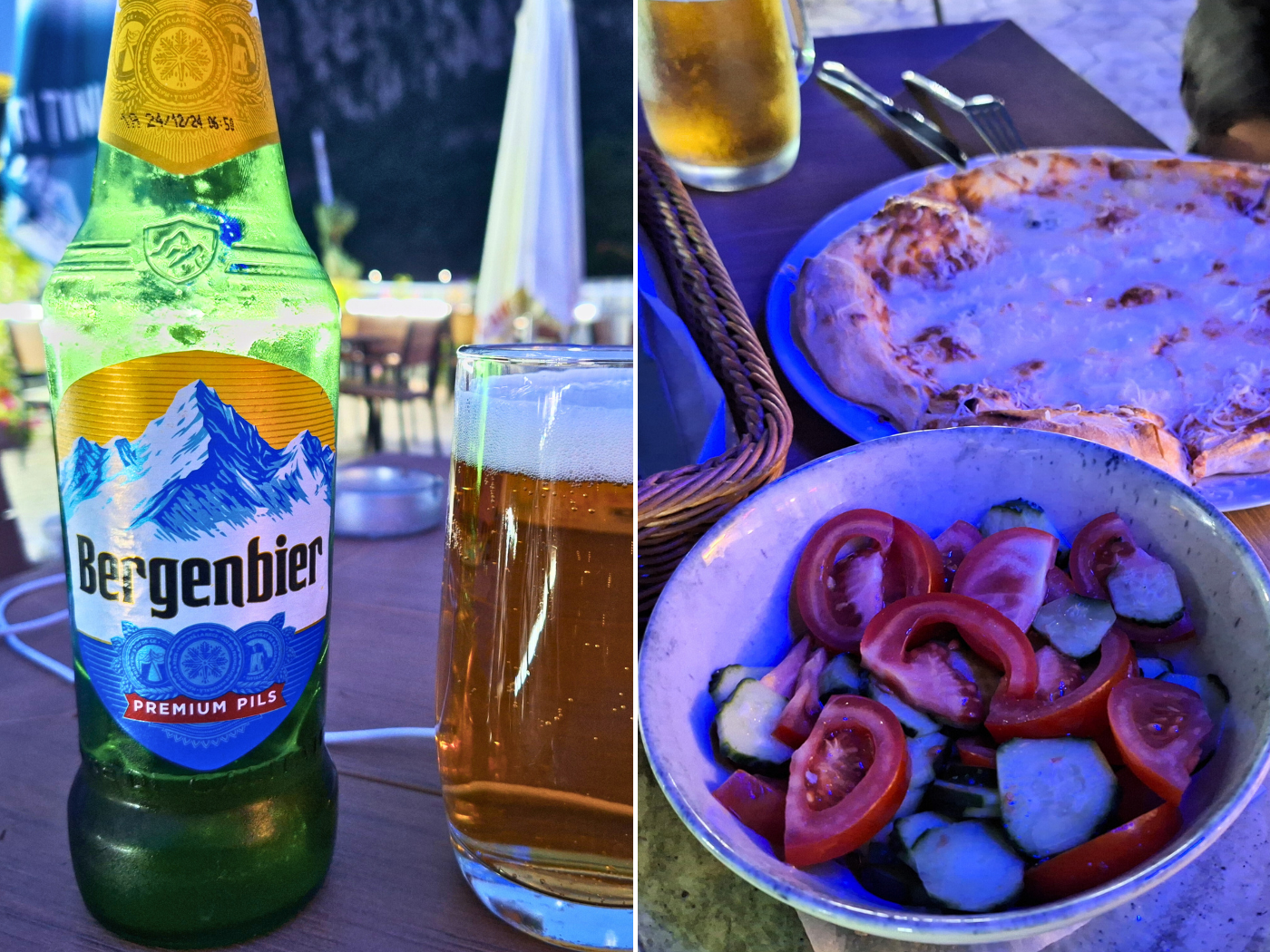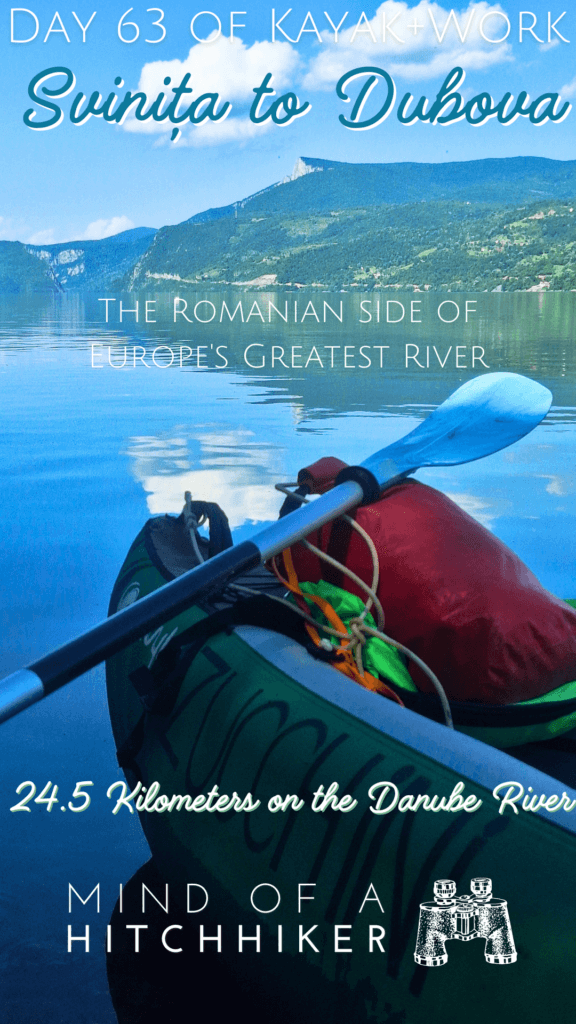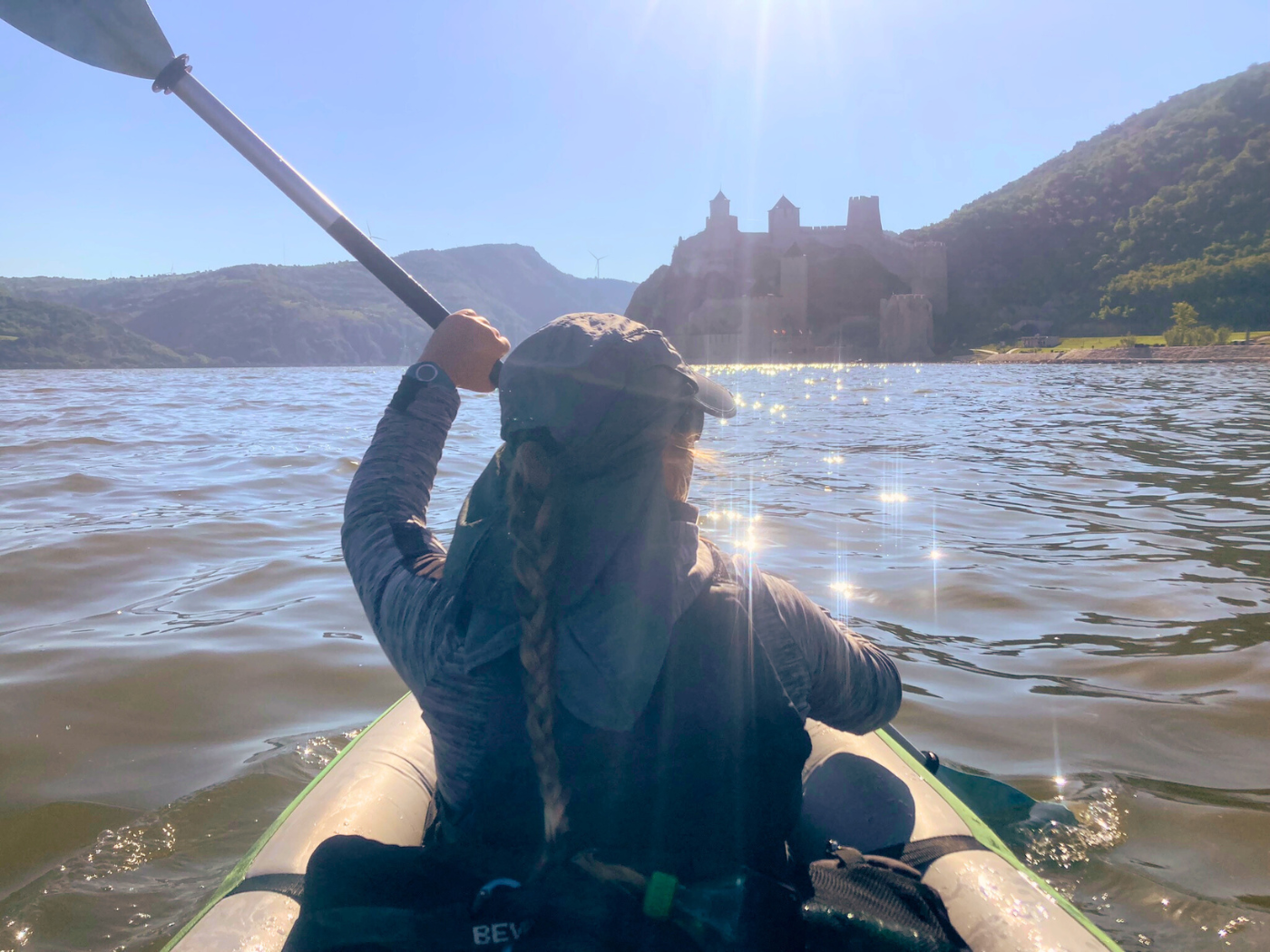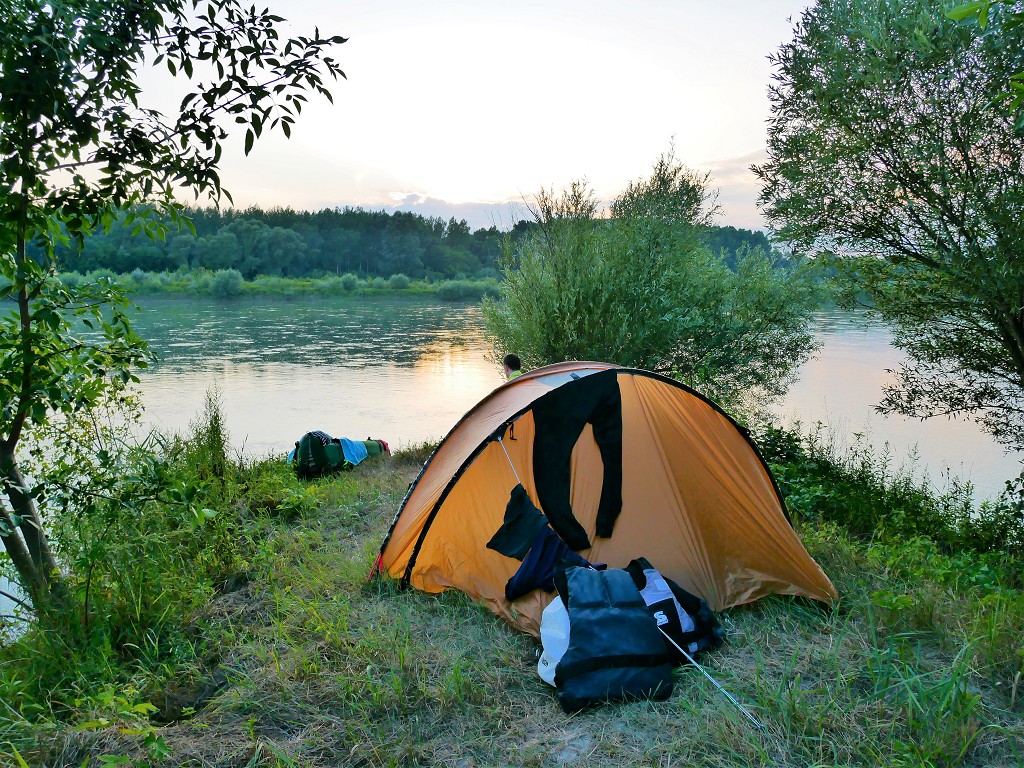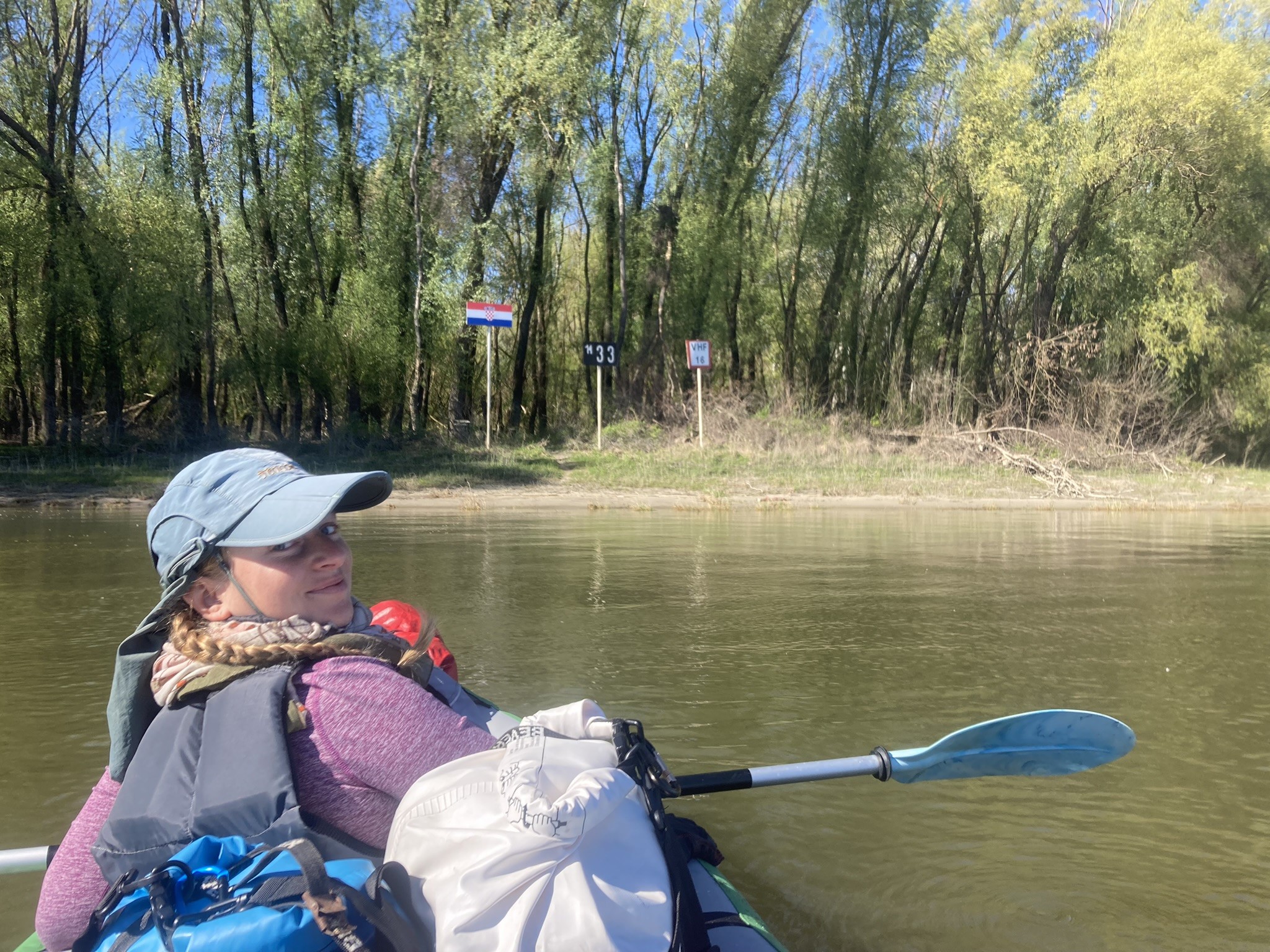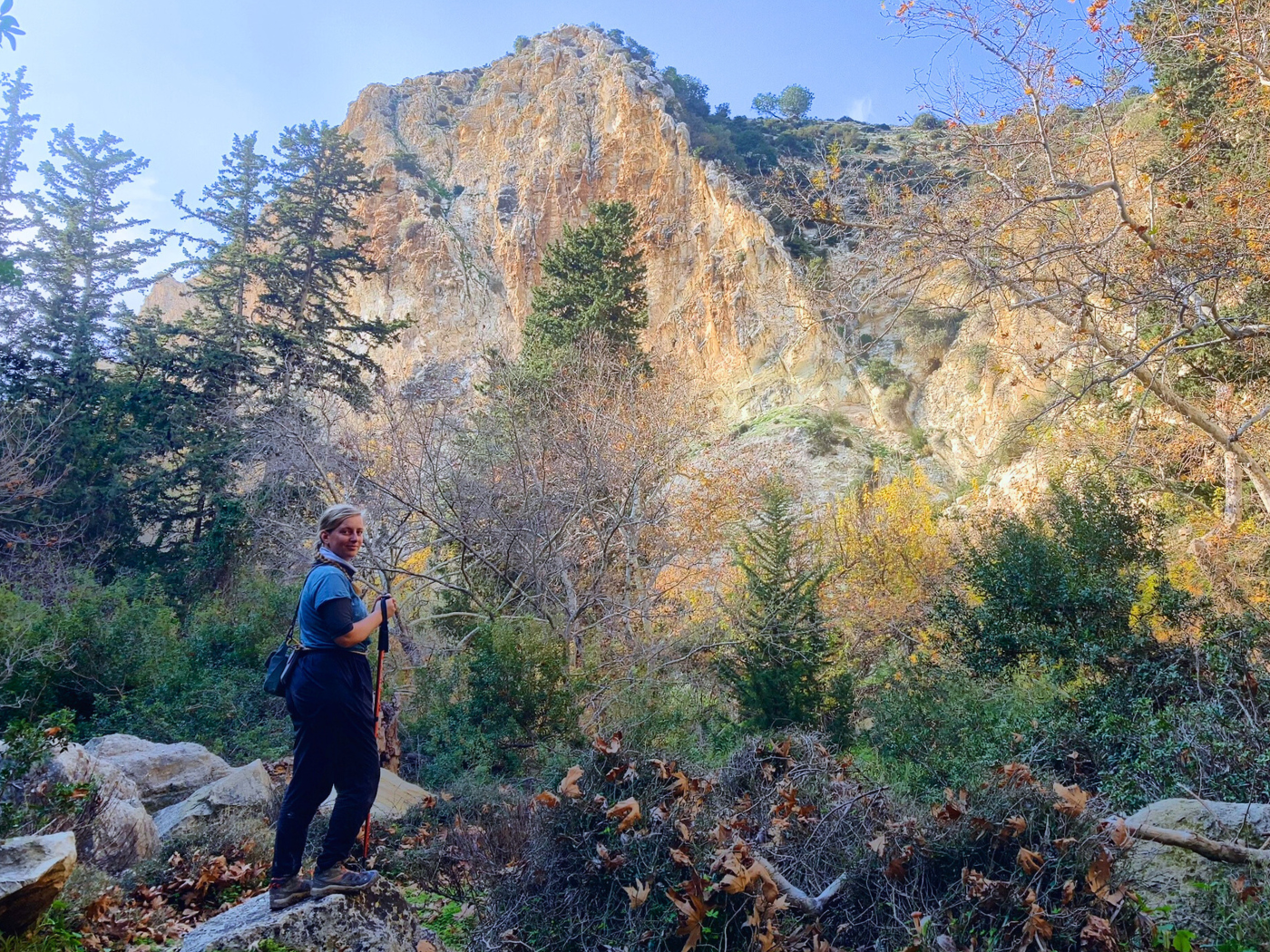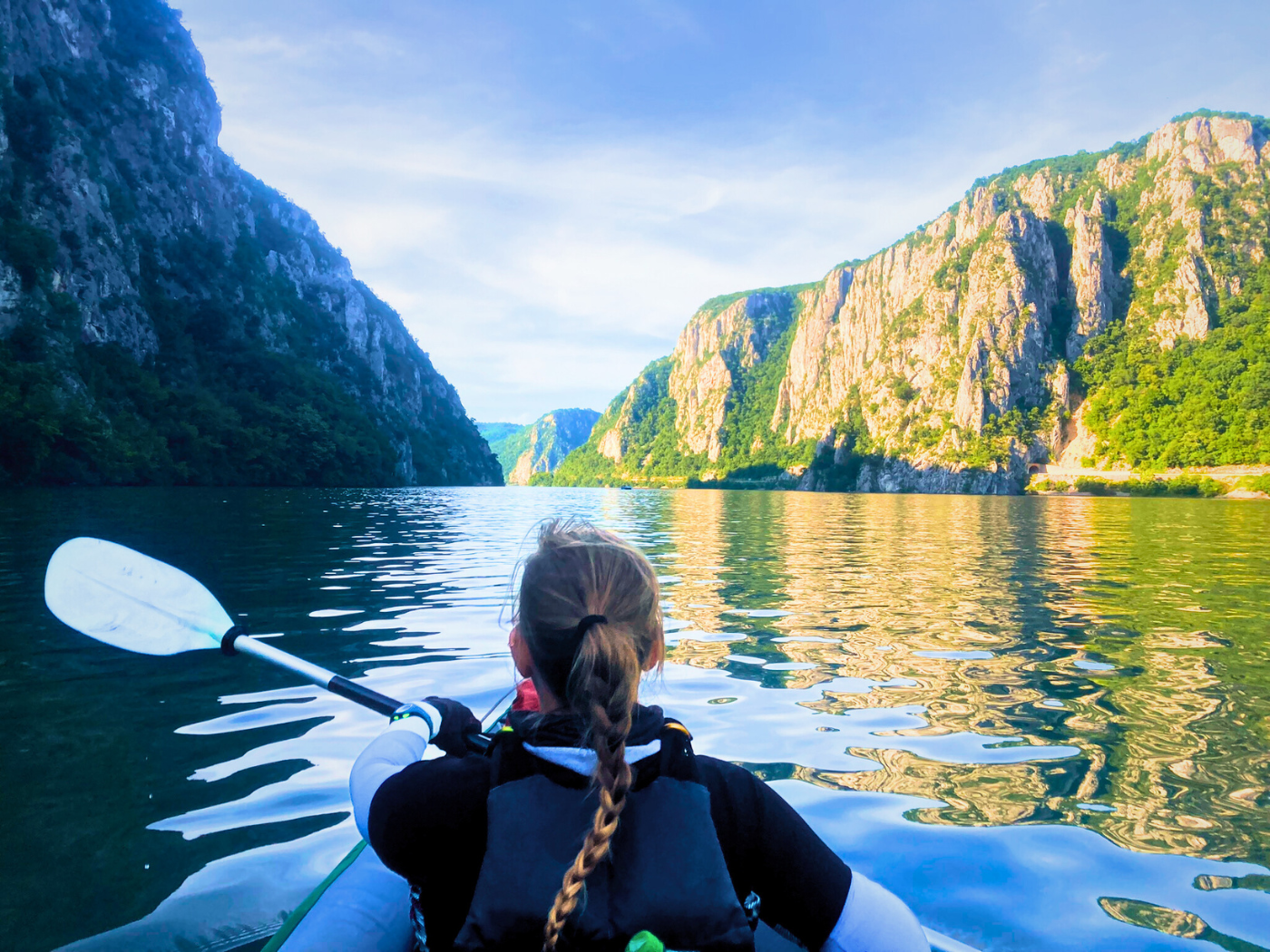
We paddled this stretch on Saturday the 18th of May, 2024. In the morning, we departed Golubac and took the ferry from Usije in Serbia to Moldova Veche in Romania, going through immigration. From there, we made a quick stop in Moldova Nouă and Berzasca before we started paddling from Svinița to Dubova. That stretch has a lot of things to sightsee: the Tri Kule ruined fortress, the Great Kazan Gorge, and several caves.
Want to travel the (entire) Danube River in an adventurous way? Join our Facebook group Danube River Source to Sea: Kayak / Canoe / Bike / Hike / Sail to find your community
Contents
- 1 Ferry from Usije to Moldova Veche: Border Crossing Horror
- 2 Paddling Out of Svinița: Cetatea Tricule
- 3 Before Dubova: Zucchini Has a New Leak
- 4 Kayaking the Great Kazan Gorge
- 5 Arriving in Dubova
- 6 Our Rainy Stay in Dubova
- 7 Helpful post? Consider buying me a Bergenbier!
- 8 I love people who share my articles
Ferry from Usije to Moldova Veche: Border Crossing Horror
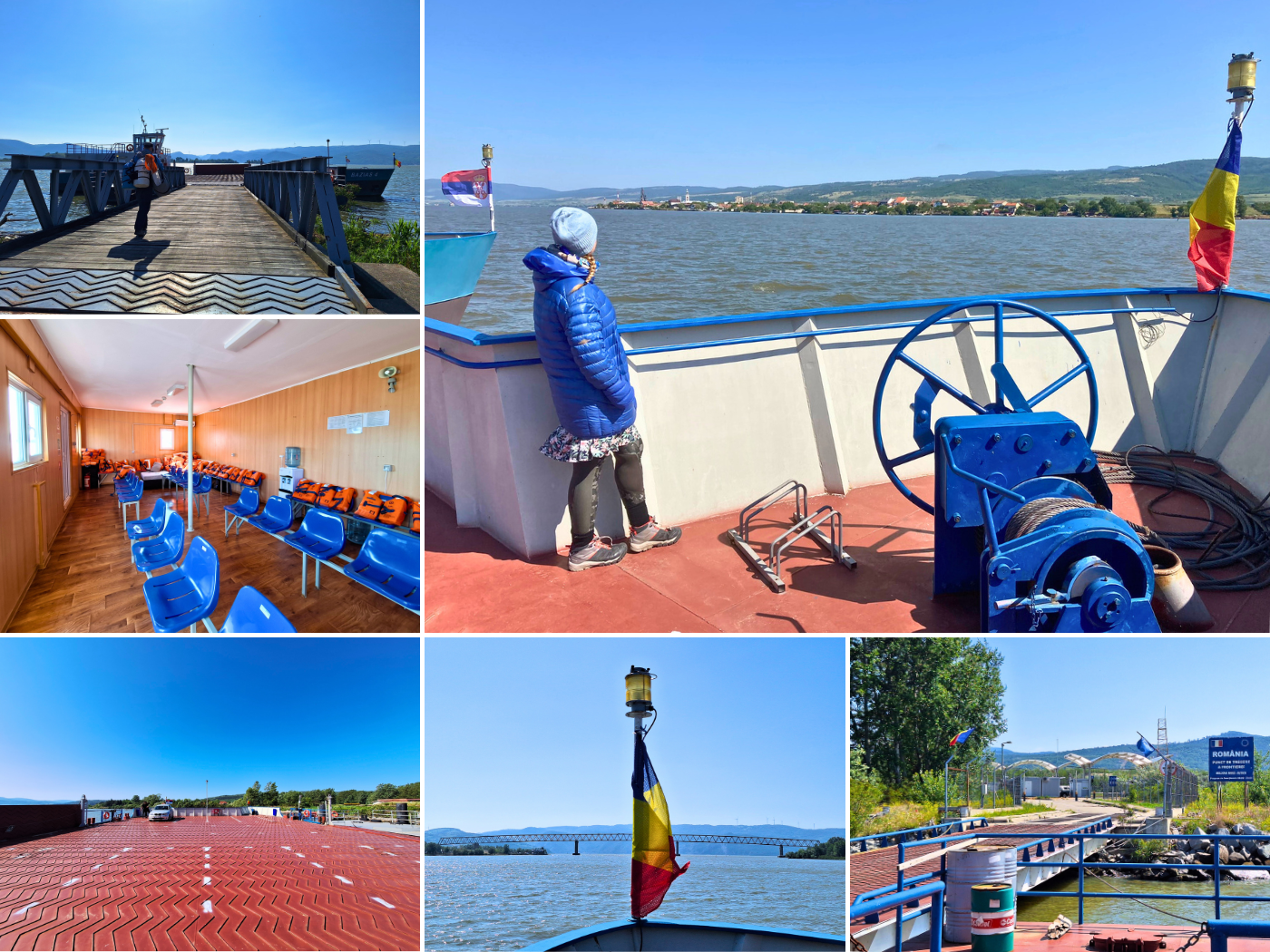
Paddling Out of Svinița: Cetatea Tricule
We started kayaking away from Svinița at 12:34 Serbian time, so add one hour to that for the Romanian time. I wasn’t exactly ready at that moment to switch over. One day I will. Jonas had set up my phone the night before so that I would stay connected to the Serbian phone network for internet. So everything was consistent, unlike the day we kayaked from Ram to Golubac.
We kayaked past a former or future guesthouse. But we first had to spend some minutes adjusting our seats. Everything felt a bit off.
There was some headwind and I was very worried that these short under 25 kilometers would be more exhausting than anticipated. I tried my best to paddle consistently, bracing myself for even stronger winds once we’d turned northeast after this river bend.
It was strange to double these two, three kilometers; we’d already done this stretch when we kayaked from Golubac to Donji Milanovac through the first part of the Iron Gates a week ago. But this time, we are on the other side and much further away from Donji Milanovac. One cruise ship was moored at our first attempt for landing and another one was just coming in around the corner.
We stuck closely to the left bank of the Danube through the turn. Eventually, we saw the towering ruins of Cetatea Tricule, alternatively, Tri Kule. It’s a wonderful sight!
It was very cool to paddle by this piece of history so closely, but I’m afraid Tricule Fortress won’t be around much longer. Up close, the two remnants look like a severely tattered Jenga tower.
I’d already seen Trikule Fortress just before landing in Donji Milanovac, but I was more than one kilometer away. And now, we were here with beautiful sunny weather, paddling closely to the precarious ruins dating back to at least the 15th century. Right now, it’s flooded because of that damned dam nearby Drobeta-Turnu Severin (Iron Gate I Dam). It caused the water levels of the Danube to rise by about 35 meters, making historical sites like this disappear. During low water levels on the Danube, it’s possible to see the foundation of the third tower. When we paddled here, the third tower was probably about a meter underwater and out of sight from us.
We took some photos and videos of this wonderful place. Jonas made a vlog to upload later. We paddled quite closely to both of them, though we know they become more unstable with each passing year. I bet the half-collapsed upstream one will collapse within this decade, while the second complete one might still be around for a while.
We continued kayaking to Dubova at 13:15 Serbian time, i.e. 14:15 Romanian time.
Before Dubova: Zucchini Has a New Leak
We eventually turned the corner of the Donji Milanovac Basin river bend. I was in an energetic dip and almost falling asleep. I asked for a snack, and Jonas provided the cereal bars we’d just bought in Romania. While good, they’re not protein bars. And I would have liked two of them.
We continued kayaking in a northerly direction, behind us, the flooded bay of what once was the Porečka River mouth. Today, it’s a vast green valley.
I measured our progress to a point on the map a few kilometers before the Great Kazan Gorge. It was counting down, but so slowly. To keep my brain awake, I sang and hummed.
Ahead the light reflected the entrance to the Great Kazan Gorge with a mountain on the Serbian side called Veliki Štrbac (768masl), towering above the Danube. But we couldn’t see exactly how the Danube flows in until a cargo ship overtook us from the back. We were tracking its approach as we also approached the canyon in a much slower fashion.
Parts of the Romanian left bank were a bit shallow with plants breaking the surface. We kept a good distance from those, sticking more to the middle of the river, hoping to catch some current as well.
At 15:16, Jonas squeezes the left chamber of Zucchini and notices it’s quite deflated. We make a sharp turn left and paddle to the Romanian side where the Liubotina stream enters the Danube. Jonas found a landing spot there. We landed and Jonas dealt with the reinflation of this chamber while I admired the many bees snatching pollen from the flowers.
In this tight spot, we also listened to the vent. We didn’t hear a leak from that obvious place. Shit, the leak must be elsewhere. Fixing a puncture in Zucchini (again) is not how we’d hoped to spend our time in Dubova. This section of the Danube is the one I’ve been looking forward to the most since 2019. I’ve literally been waiting for this for five years.
All we could do now was pump up the left chamber some more. While he was at it, Jonas also found the right chamber a bit low on air. I didn’t think it was necessary to overinflate that one, but it made the left one look very soft in comparison. We headed back onto the river at 15:36 Serbian time after this 14-minute ordeal.
Now that we knew our time on the river was limited by how long the left air chamber stayed inflated, we paddled a lot faster and took turns eating our boat pizza while the other one continued. In this sunshine, I got very warm. But the views were incredible and the water was like a perfect mirror.
We approached the Great Kazan Gorge. Another ship went inside it. I was ready to go do it, but Jonas squeezed the left chamber again and made an executive call to land again to inflate it. I could almost taste the canyon.
Or maybe we should call it quits and call Razvan for (another) pickup?
Jesus fucking christ.
On the Romanian side, we couldn’t find a great landing spot on land. But we did find a floating platform remotely attached to someone’s property. They and their dogs weren’t home, so Jonas landed the boat there, climbed onto the platform, whipped out the pump, and pumped Zucchini up again. This was one hour after the last time we pumped Zucchini up. Did the leak really just happen out of nowhere? Is she experiencing PVC fatigue?
Jonas hopped in the boat, determined to kayak to Dubova but in a bad mood. All of this is not going the way I hoped it would. I was hoping for a pleasant sightseeing paddle through the Great Kazan Gorge, but instead we’re just experiencing tensions between us and a lack of tension on the left air chamber. Jonas said he didn’t want to take photos in the canyon and just kayak through. Then we might as well call it quits. But I was hoping he would change his mind about that.
Motherfucking hell.
Kayaking the Great Kazan Gorge
At 16:53 Serbian time, we found ourselves paddling into the squeeze of the Great Kazan Gorge. Its late afternoon shadows hit us and cooled us down pleasantly. We are now cutting through the Carpathian Mountains in the narrowest part. The mighty Danube narrows to about 150 – 170 meters in width here, with cliff walls surrounding her towering 300 meters directly above her.
And still, sitting in a humble inflatable kayak, it felt quite spacious.
Many tour boats were zooming up and down the Danube in this area. That’s when I remembered it was still Saturday, the weekend. Not the kind of day I would normally choose to go kayaking, but right here in the Iron Gates, we choose to go out like this: wind > weather > weekend. The wake from these small boats was a little annoying, but nothing we couldn’t manage.
Our first stop on this sightseeing tour is the plaque dedicated to some Hungarian fella called Széchenyi and Hungarian engineers, who worked on improving navigation in this area in the 1830s. But this one looked quite shiny and new, so, presumably like all things in this area of the Danube, the original one is somewhere underwater today.
We continued paddling with the deflating left chamber in the back of my mind. I didn’t touch it to find out, because I was living in denial as my mind went back and forth on it in my skull as my skull was stuck between these two cliffs. Don’t think about rockfall. Oh shit, now I’m thinking about a rock falling on my head here. At least that will put an end to it.
The next sightseeing thing was the Danube entrance to Ponicova Cave (Romanian: Peștera Ponicova). There’s an entrance via land some 400 meters away and the stream that flows through the cave enters the Danube here. It’s the biggest cave in the Iron Gates area. We kayaked to its entrance and were tempted to go inside, except for this brutal cold air that emanated from the chasm and a kind of fear of the darkness that came over me. We took some photos and videos. There was also a sign in Romanian saying something about the nature here. Perhaps it’s also forbidden to kayak into the cave (it’s not). But the opening also looked very narrow for our rather wide kayak.
When driving with our host Razvan from Dubova to our launch spot, I mentioned this cave. He said he’s a tour guide and also visits the cave regularly, so I’m stoked to also visit it from the other side. Hopefully, we will see the Danube from inside the cave.
Next, we kayaked towards the Veteran’s Cave past some signs for the big professional ships. One sign said “no passing”, which I thought was a bit late for that since we were in the middle of the canyon.
This cave doesn’t have a human-sized exit on the land side of the mountain and is only reachable from the Danube. It has a jetty for ships to land, but there were a lot of signs that said it was forbidden to land there. The jetty looked rather neglected as well.
But we really needed to land to pump up that left air chamber again. There’s a little stone beach below the cave at low-ish water levels like today. I think the water levels were 20 – 30 centimeters lower than normal, judging by the harsh lines on the cliff face. We landed on that beach below the cave entrance. Jonas was the only one who got out to pump up the boat, while I stayed inside and dealt with the wake from little tour boats that passed back and forth over the river, their captains looking in our direction with suspicion. It’s not like we’re going to enter the cave by ourselves.
Good thing, because one of the many warning signs here apparently read that the cave is closed because it’s unstable. There are currently also no tours to the Peștera Veterani.
We continued paddling at 17:23. This middle section of the Great Kazan Gorge isn’t that narrow. The narrowest part is at the exit into the Gulf of Dubova. We simply enjoyed the paddling in this area of the gorge. The lack of wind here was wonderful and completely unexpected. And then… the moon rose above Štrbac in Serbia. Incredible.
In the shadow, we continued paddling past so many tour boats, big and small. People wanted us to wave back and captains honked their horns. Tipsy? At least some of them. But their wake was a little annoying.
The Serbian side didn’t see much boat traffic, but the road there goes at the water. I must have taken the bus from Belgrade to Kladovo via this gorge, but perhaps it was in total darkness. Or perhaps I was asleep. Anyway, I don’t have memories of seeing this gorge before. One spot on the Serbian cliff side has a Serbian flag painted on the walls. Terrible, in my opinion. I thought the Széchenyi plaque was already a bit of an eyesore. Please don’t deface natural wonders like this.
I still wanted to touch the walls of the canyon, so we paddled more to the Romanian side to touch the parts that were firm or ready to crumble down. I wouldn’t want to be here when that happens. Though I had a close look, I didn’t see the unique-to-this-area yellow Danube tulip bravely growing on the rocks. Perhaps mid-May is already too late to see them bloom.
At 17:47 we paddled out of the Great Kazan Gorge through the narrowest part of the canyon. The widening to the Gulf of Dubova was a bit surreal. On this side, there were many signs for the big cargo and cruise ships about only going through one direction each. Makes sense, as these barges are 11 meters wide. There were also beacons anchored in the cliff walls that flashlights at night.
Arriving in Dubova
Around the corner of the Great Kazan Gorge, we paddled into the wide Gulf of Dubova. It’s really big. I expected some weird currents here, but it wasn’t anything noticeable. To our right is the Little Kazan Gorge, which is the continuation of this section of the Iron Gates. There are some more things I’m looking forward to: the historic Tabula Trajana, the Mraconia Monastery, and the Decebalus rock carving. That will be on the day we kayak to Orșova. Let’s hope we can even do it in Zucchini.
We aimed for a green area in Dubova. Kayaking in a straight line worked remarkably well. Though we had decided on an exit spot the day before, we couldn’t find great footage of it online, so it was still a bit of guesswork. I had mapped something to a picnic table on the shore.
Upon closer approach to the buildings in Dubova, we knew it was a troubled place. All the waterfront properties were built side-by-side with no gaps. And almost all the houses had platforms on the Danube that were very high. Since it was Saturday before sunset, there were quite some people sipping wine and beer from those platforms. Worst case, we could ask some of those people if we can use their space to get through to the main road behind them. We paddled up a little stream that entered the gulf here, but there was no way out there either.
The entire waterfront area of Dubova is built shut. Except this one place where it’s a foundation of yellow gravel that hasn’t seen construction yet. Perhaps someone’s broken dreams of having a house on the Danube here. It was very steep and generally not great, but we could do it.
We landed Zucchini there at 18:19 Serbian time or 19:18 Romanian time. It was one of our slowest kayaking days yet, but we also did a lot of sightseeing and had many troubles. Also, doing this so late in the day means we don’t have our morning energy boost to get us there.
Jonas put the CabinMAX and my personal dry bag on the embankment. Getting Zucchini up there was not a lot of fun, but we managed. Still, I hope we can pick a better launch spot for when we continue kayaking to Orșova.
I began packing up while Jonas took some items to our accommodation in Dubova. He checked it out in relation to if it has a garden and if we can dry Zucchini there. With the sun disappearing beyond the mountains, we couldn’t dry Zucchini anymore.
I had a little chat with some passersby in somewhat French. Jonas returned soon with information on how to proceed. We ended up carrying Zucchini inflated to Razvan’s guesthouse where we were (not) welcomed by their big outside dog. He didn’t like Zucchini and barked a lot at it.

